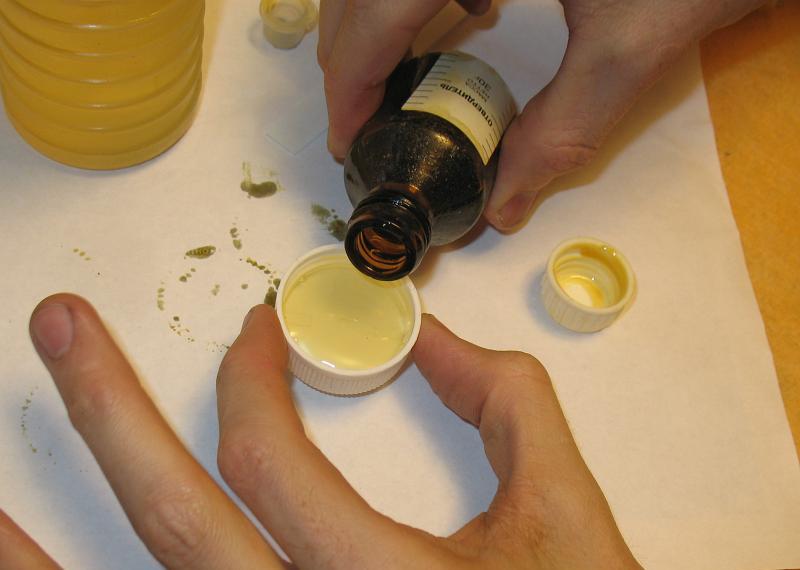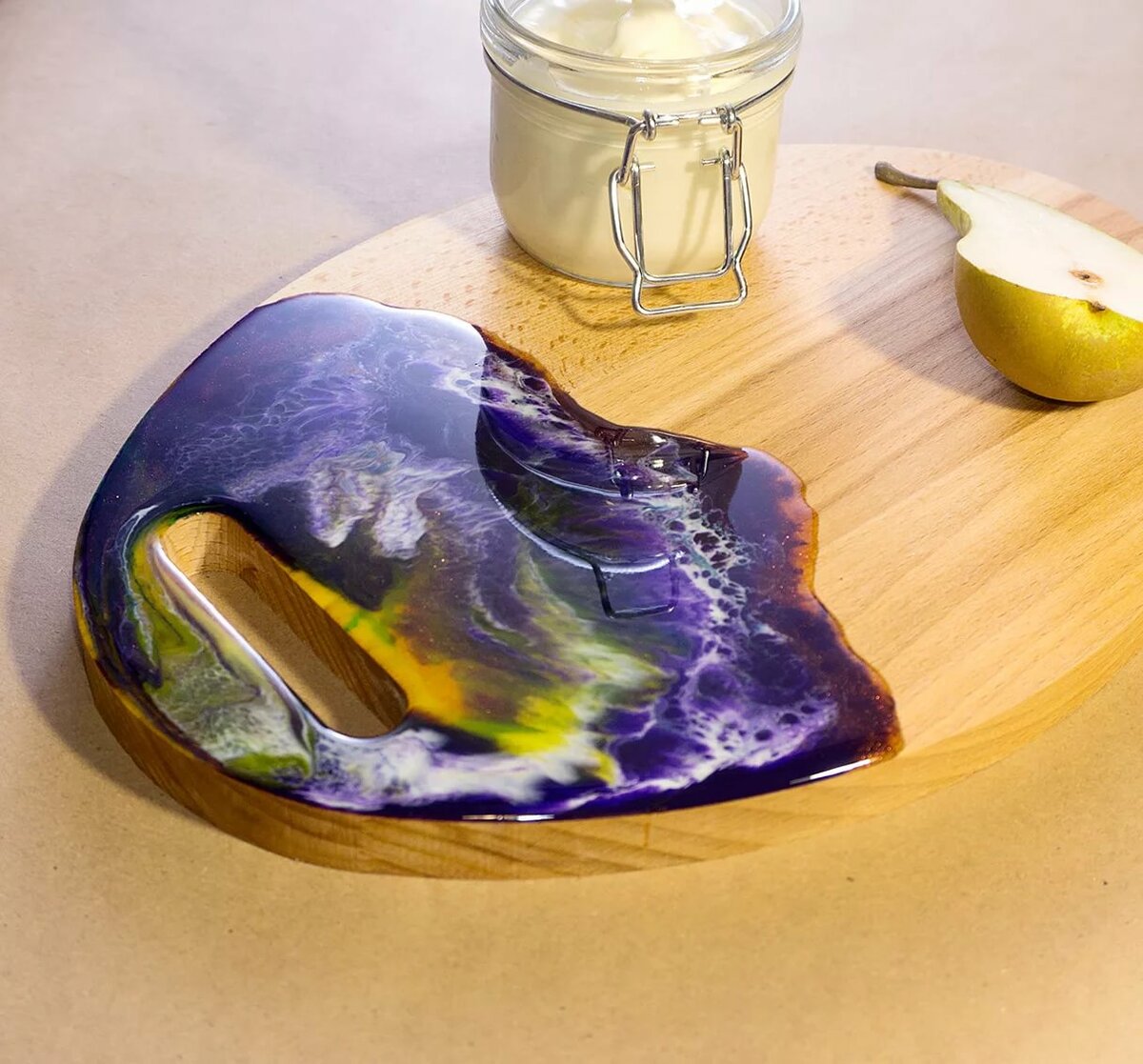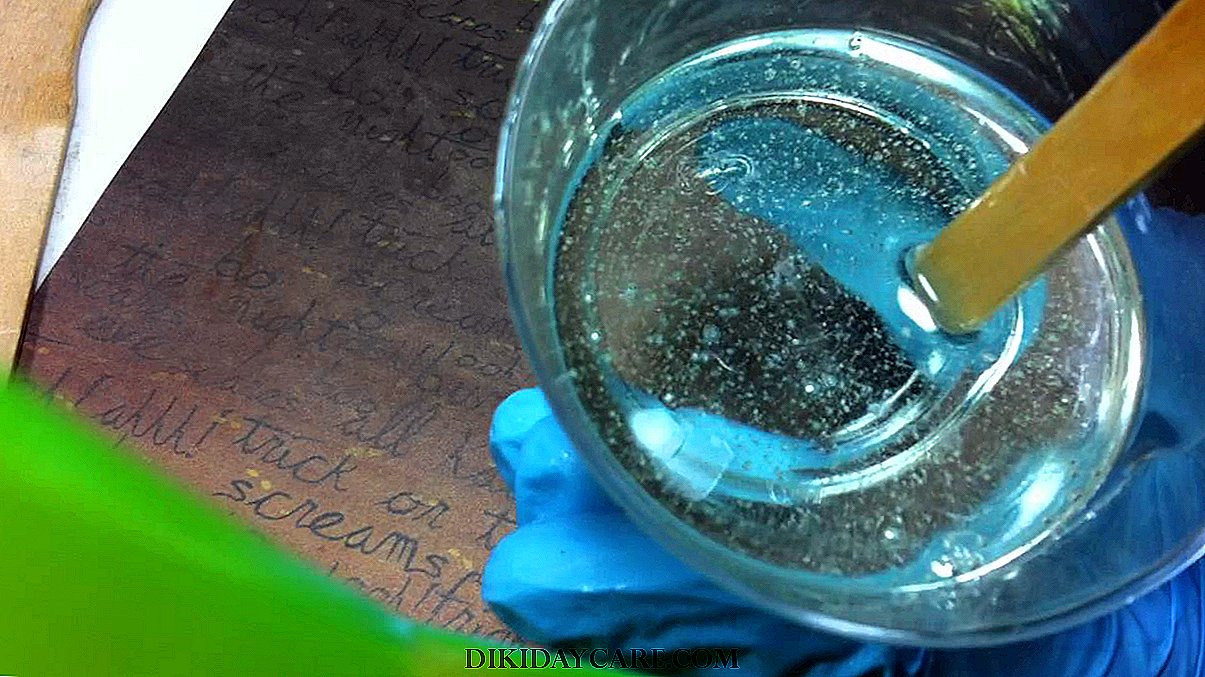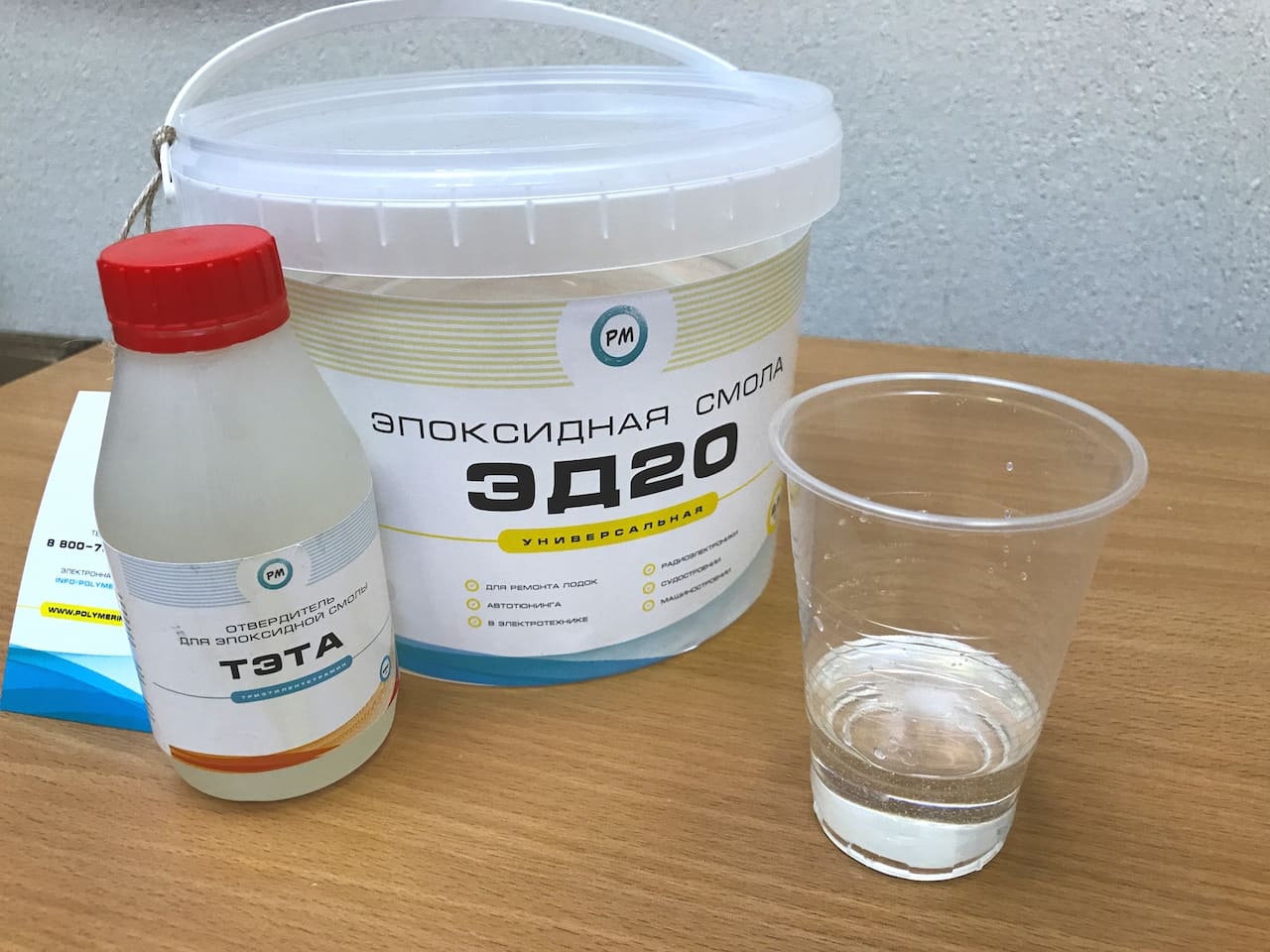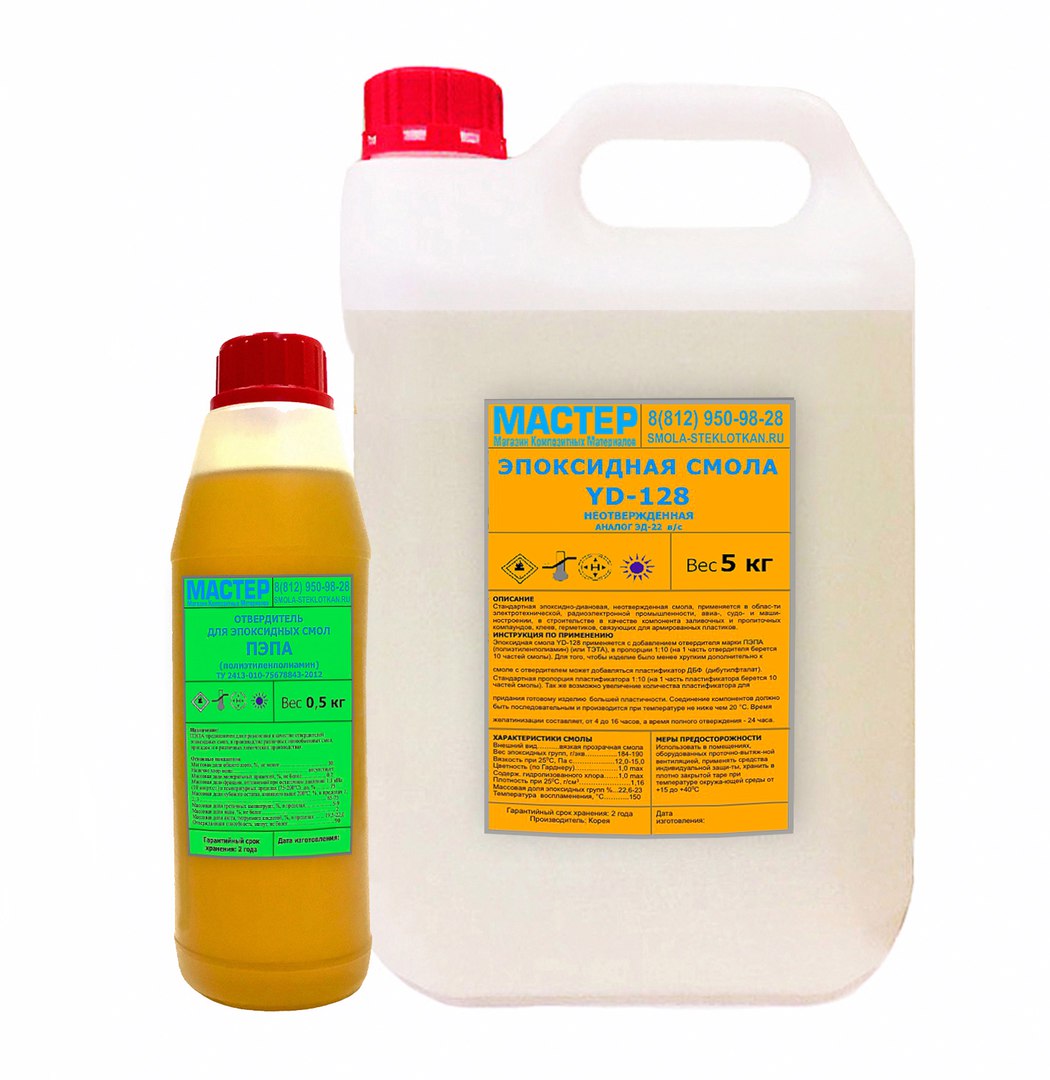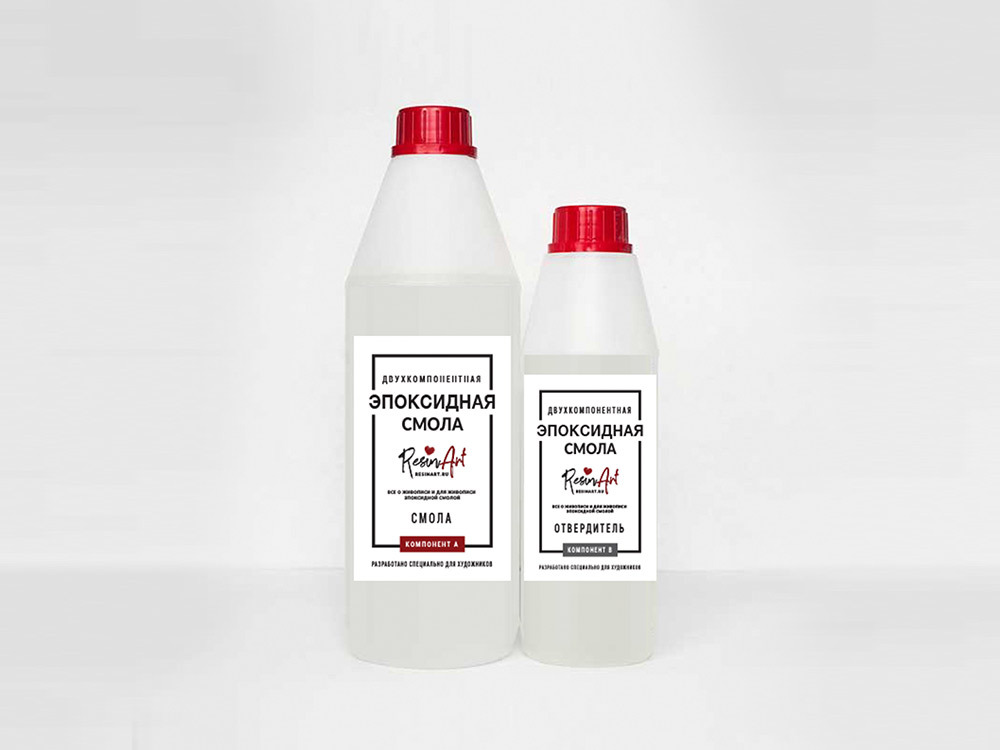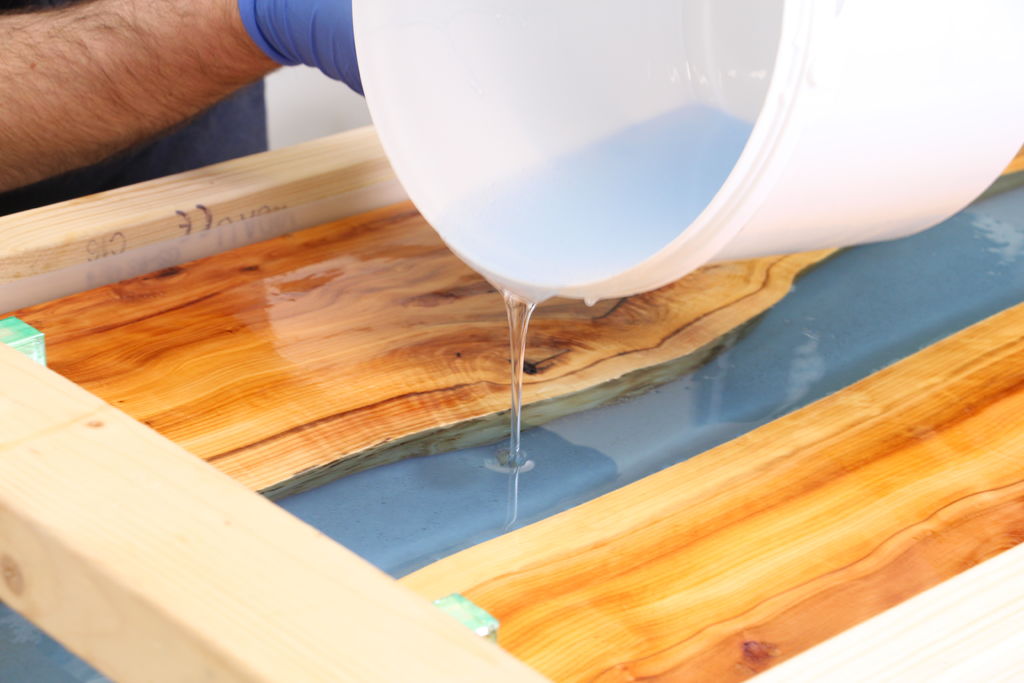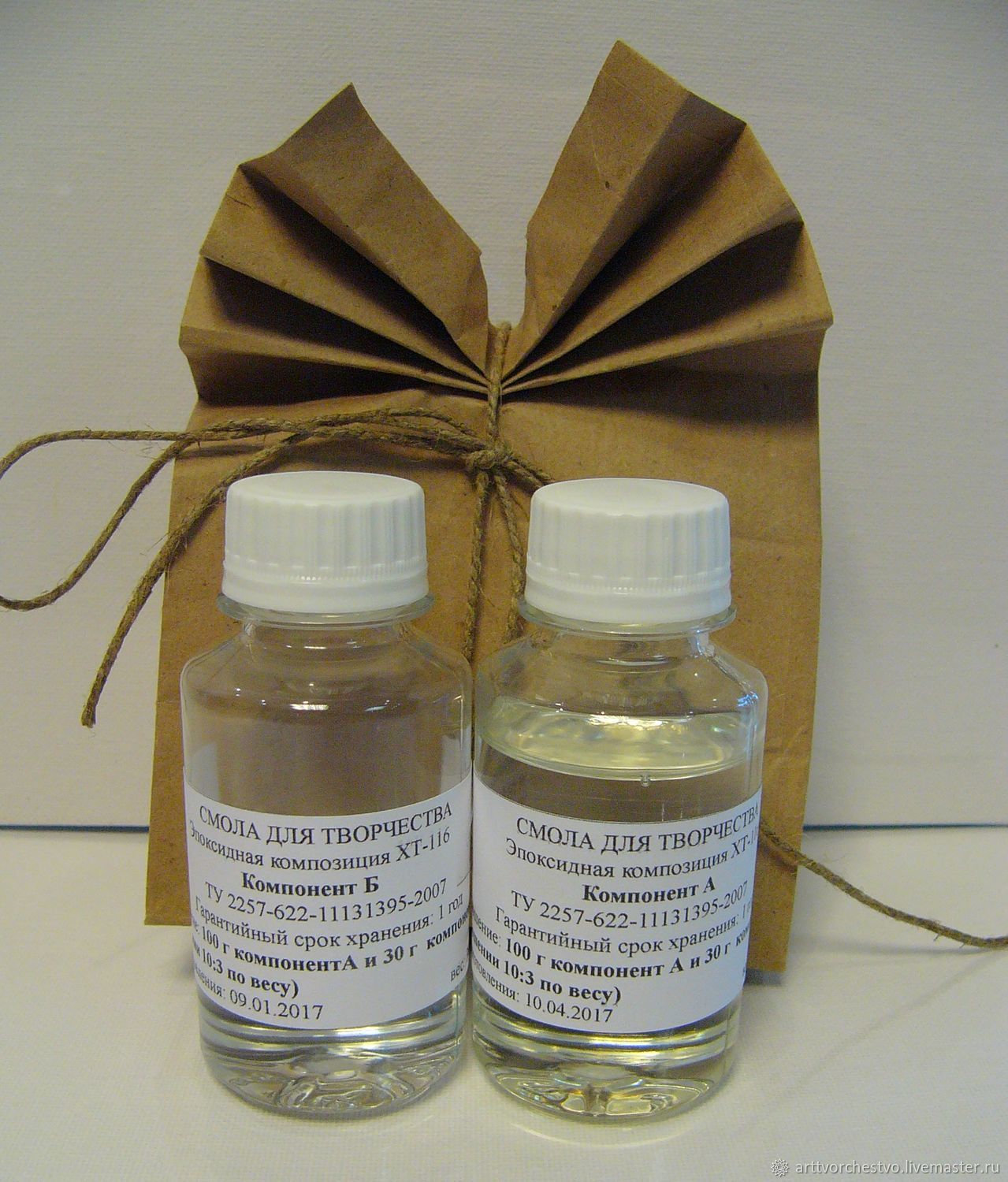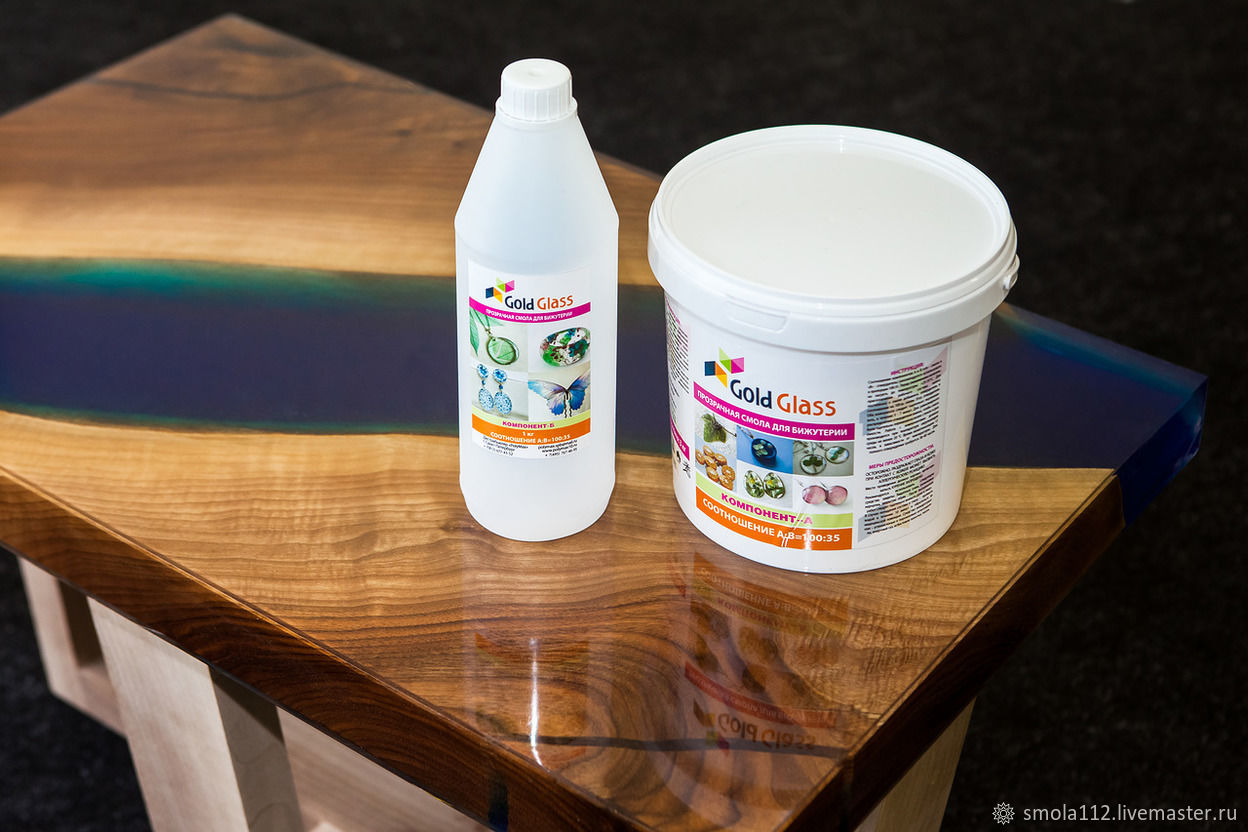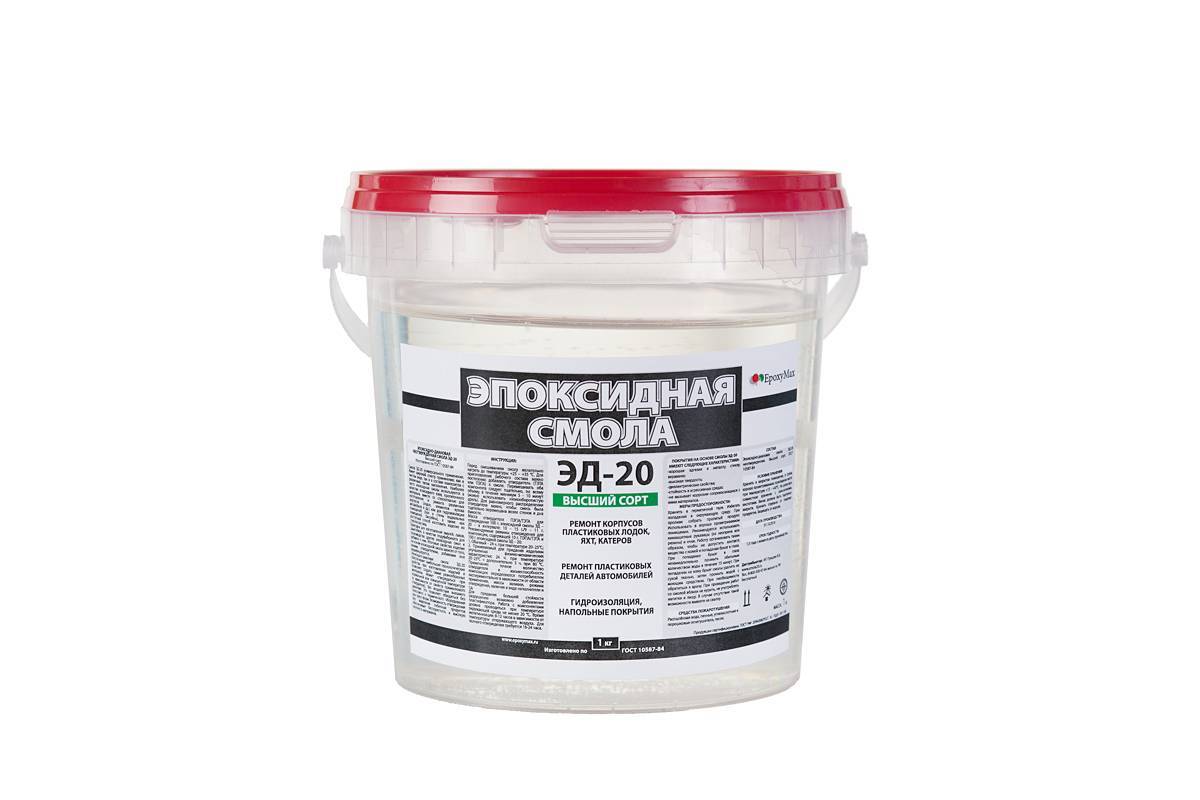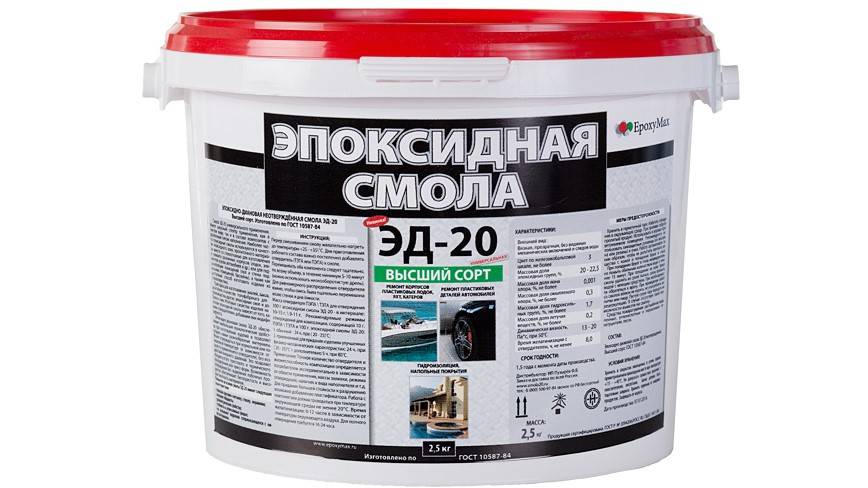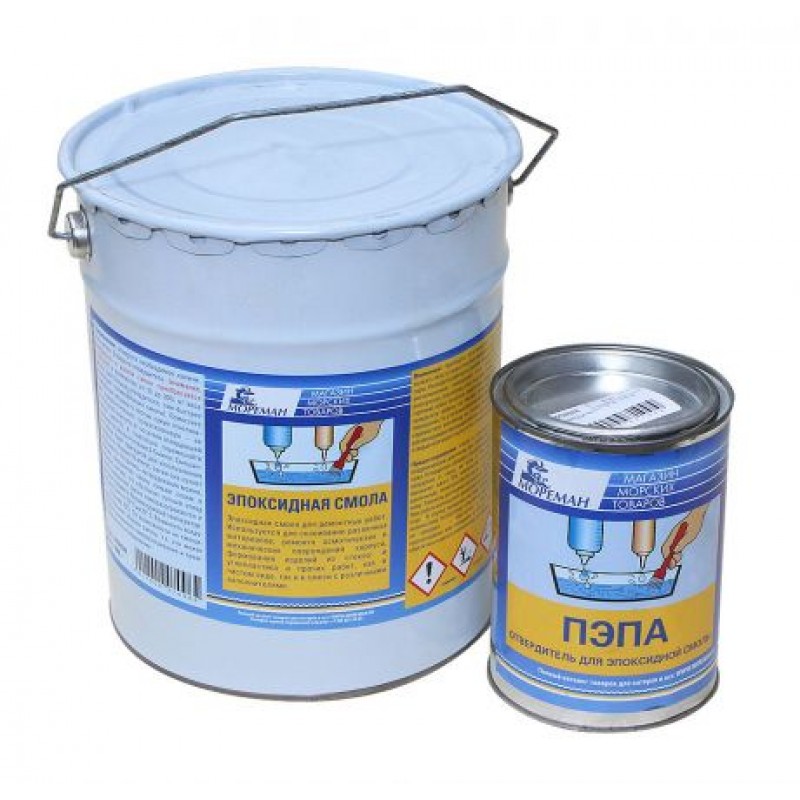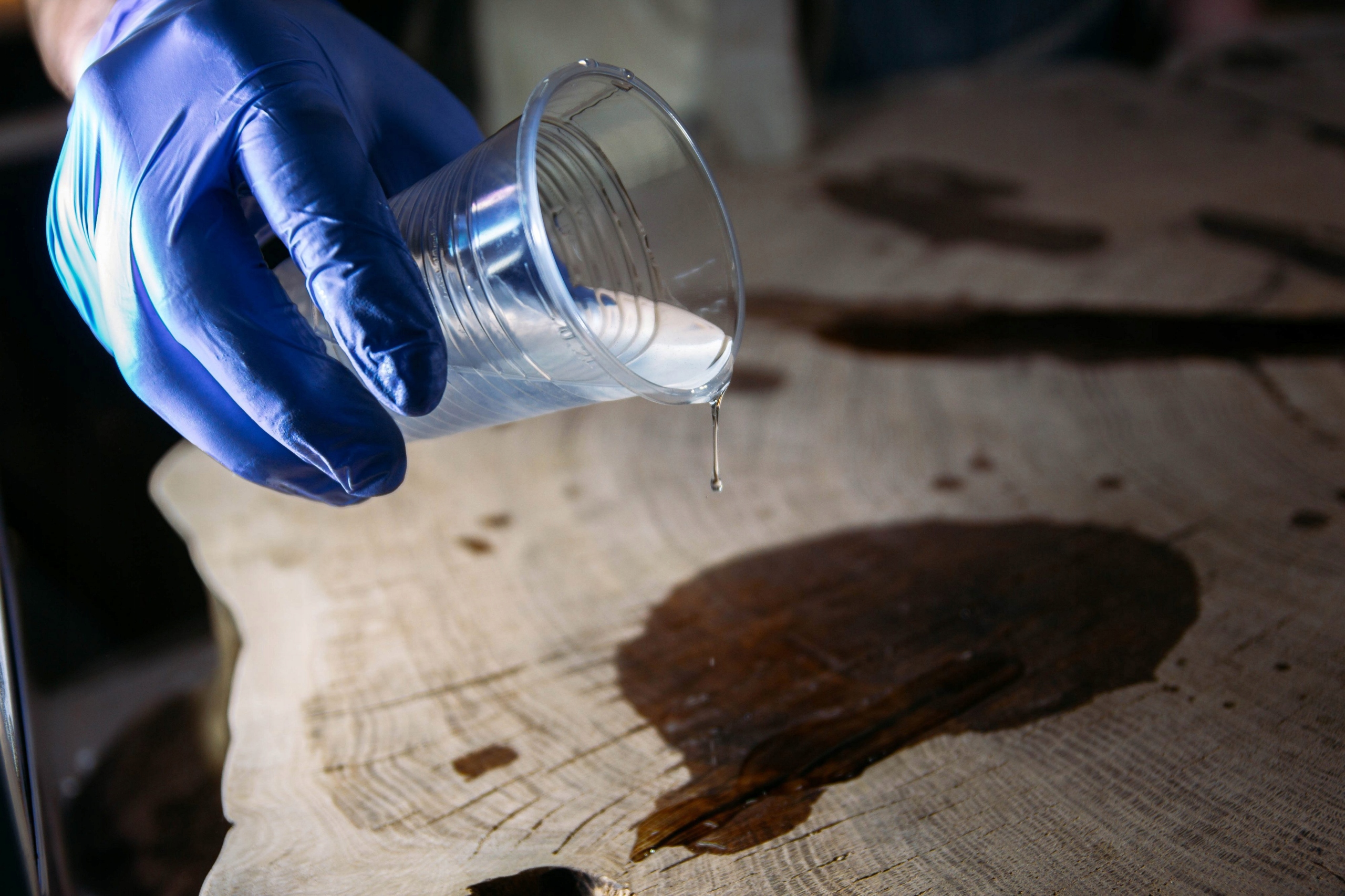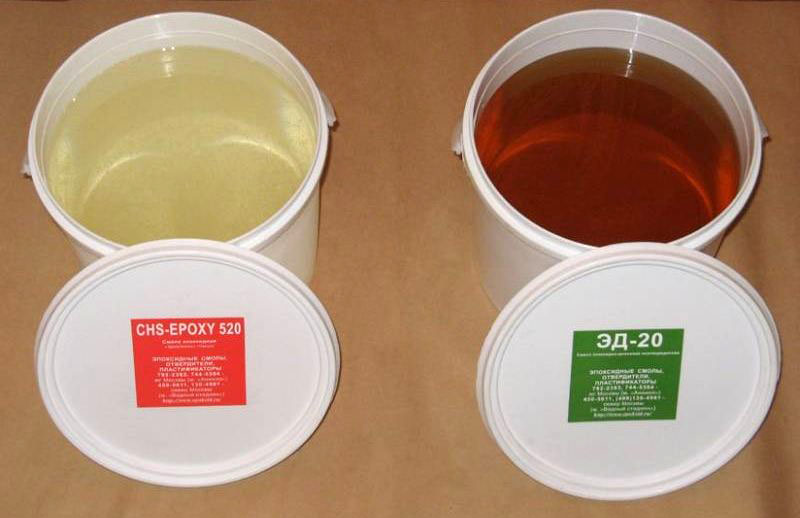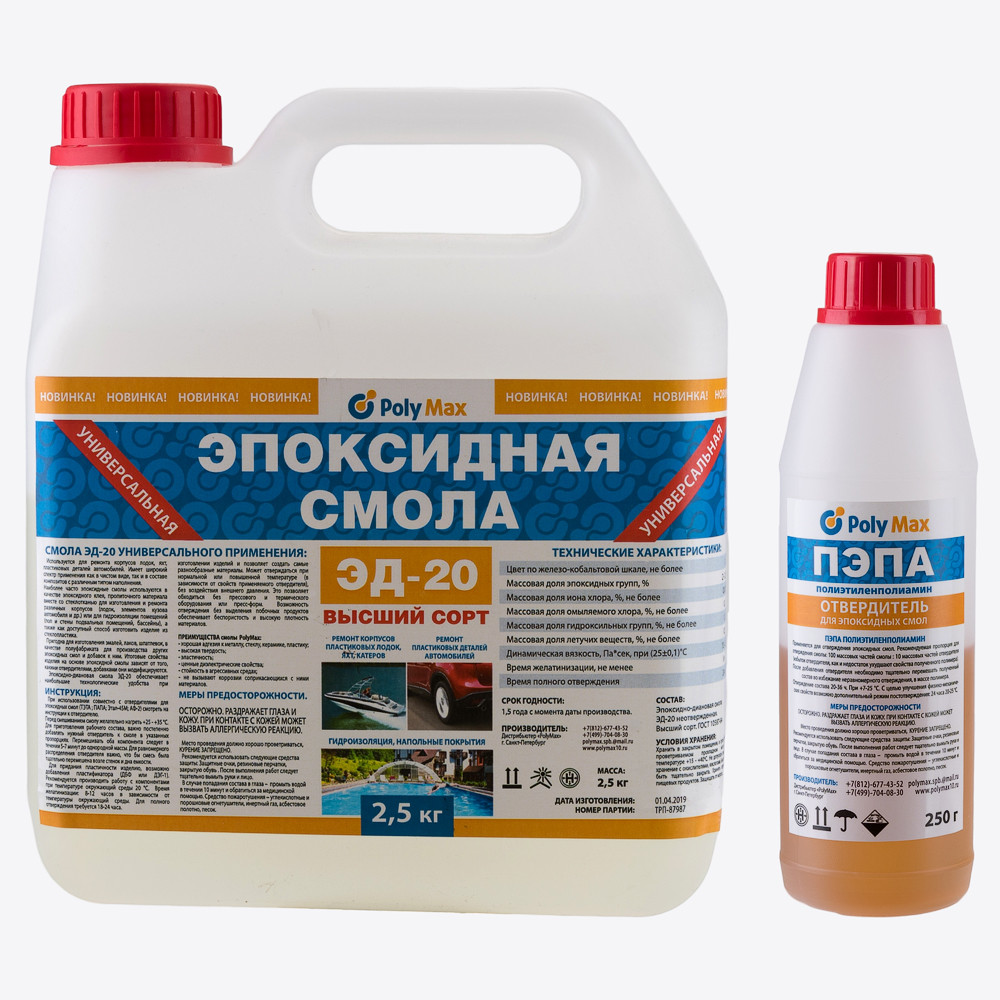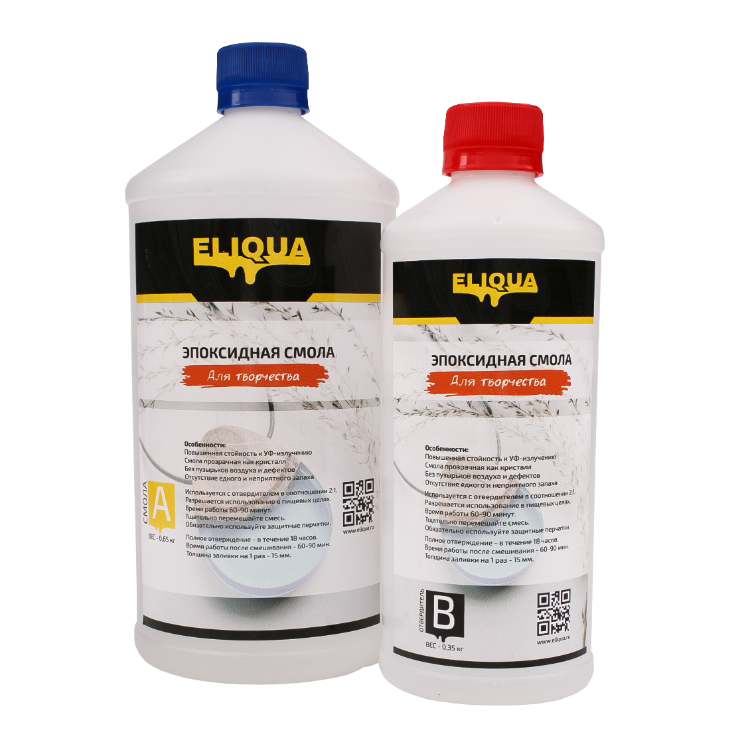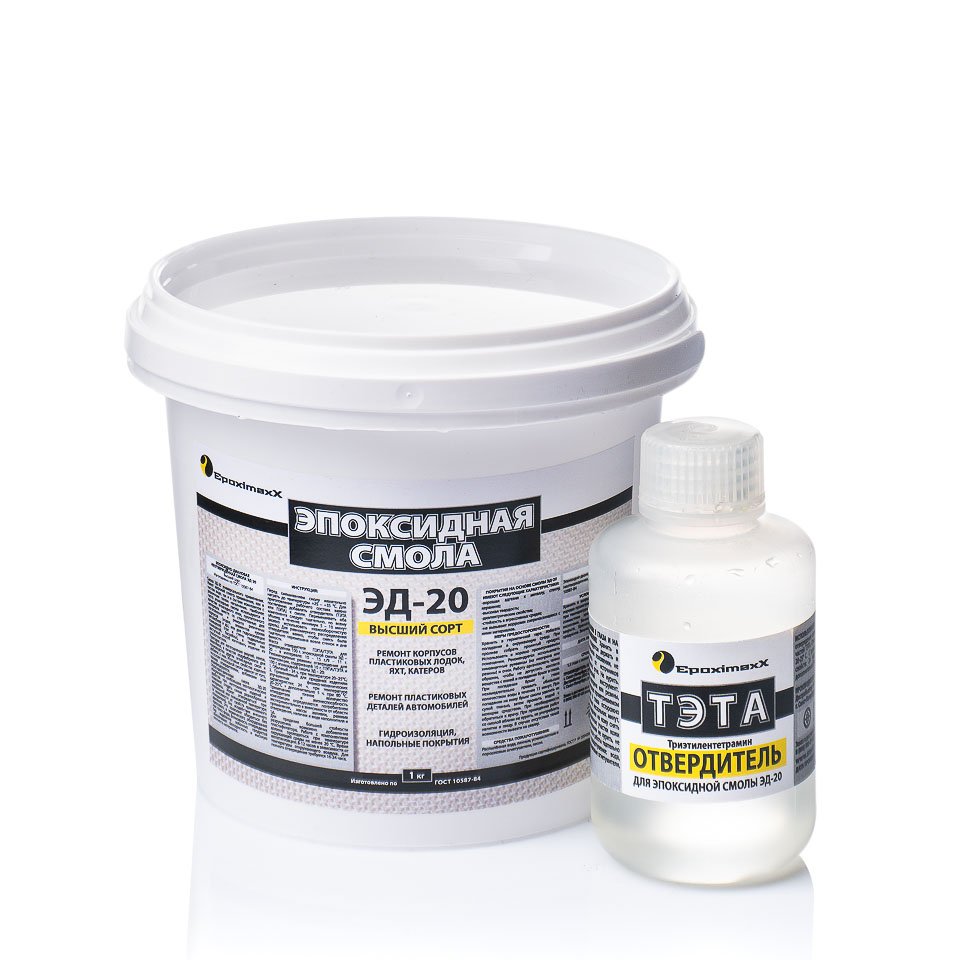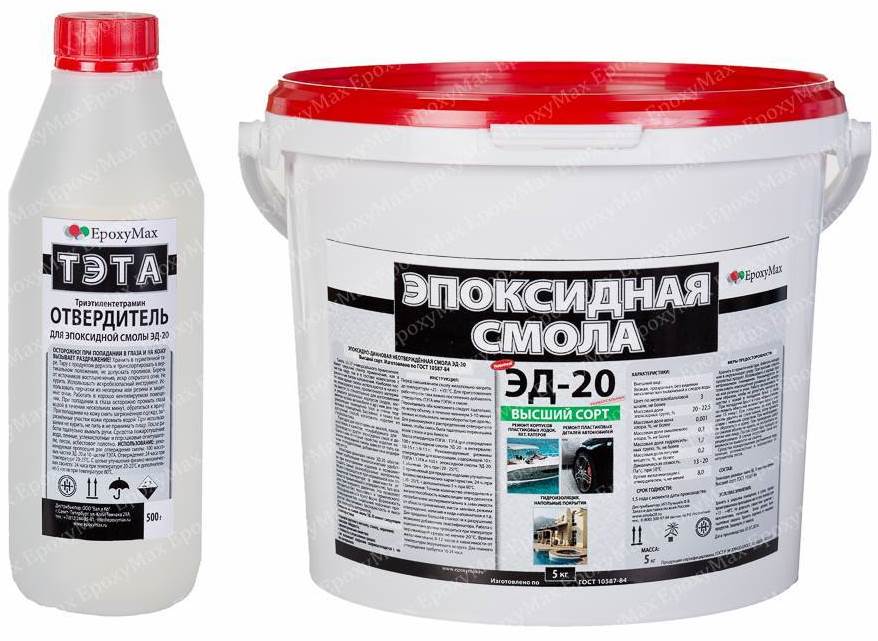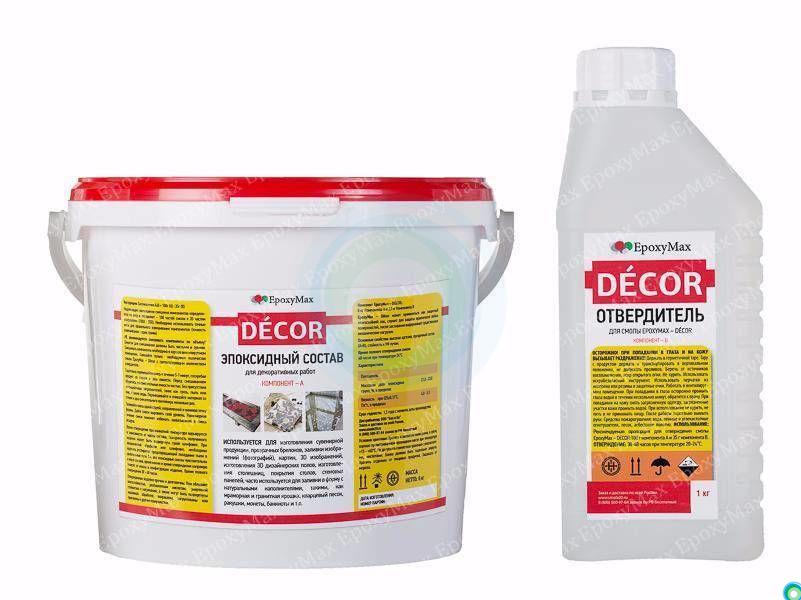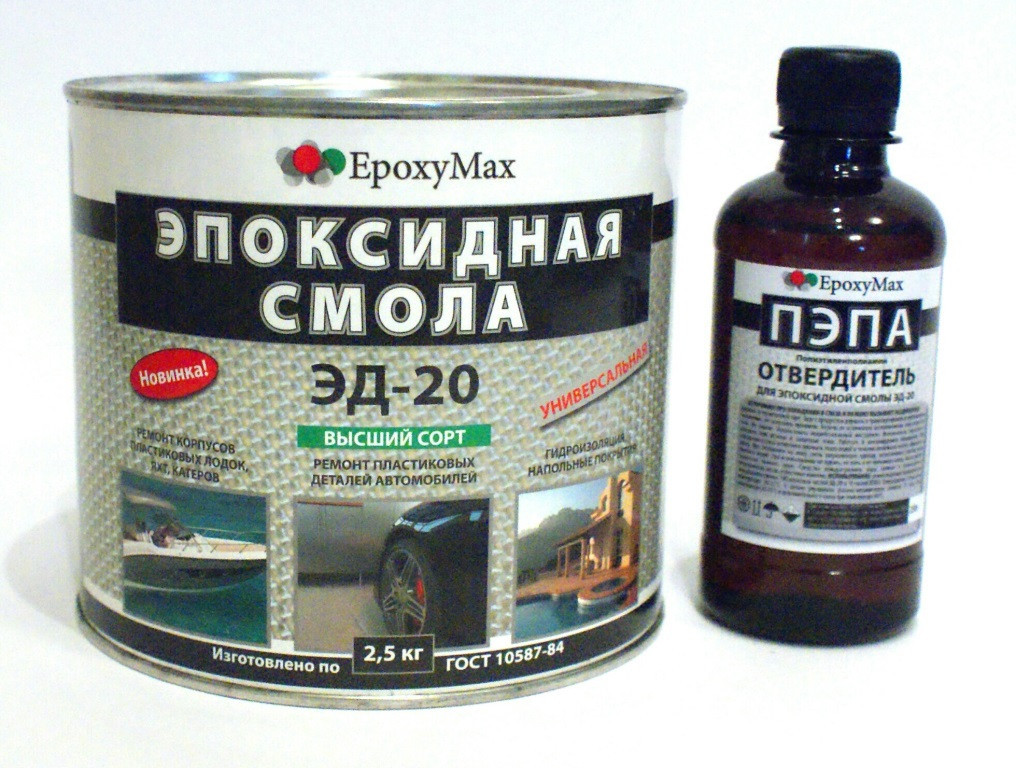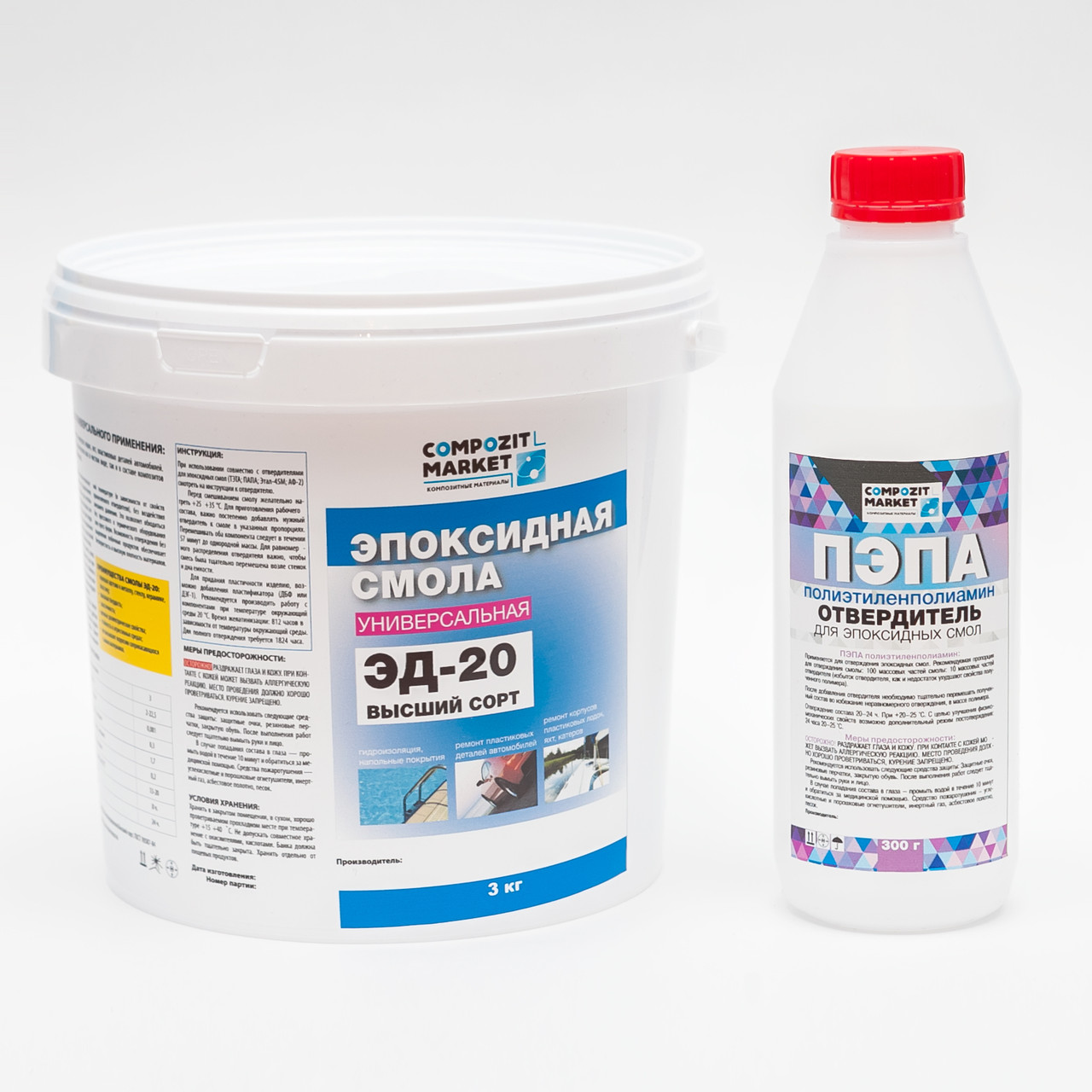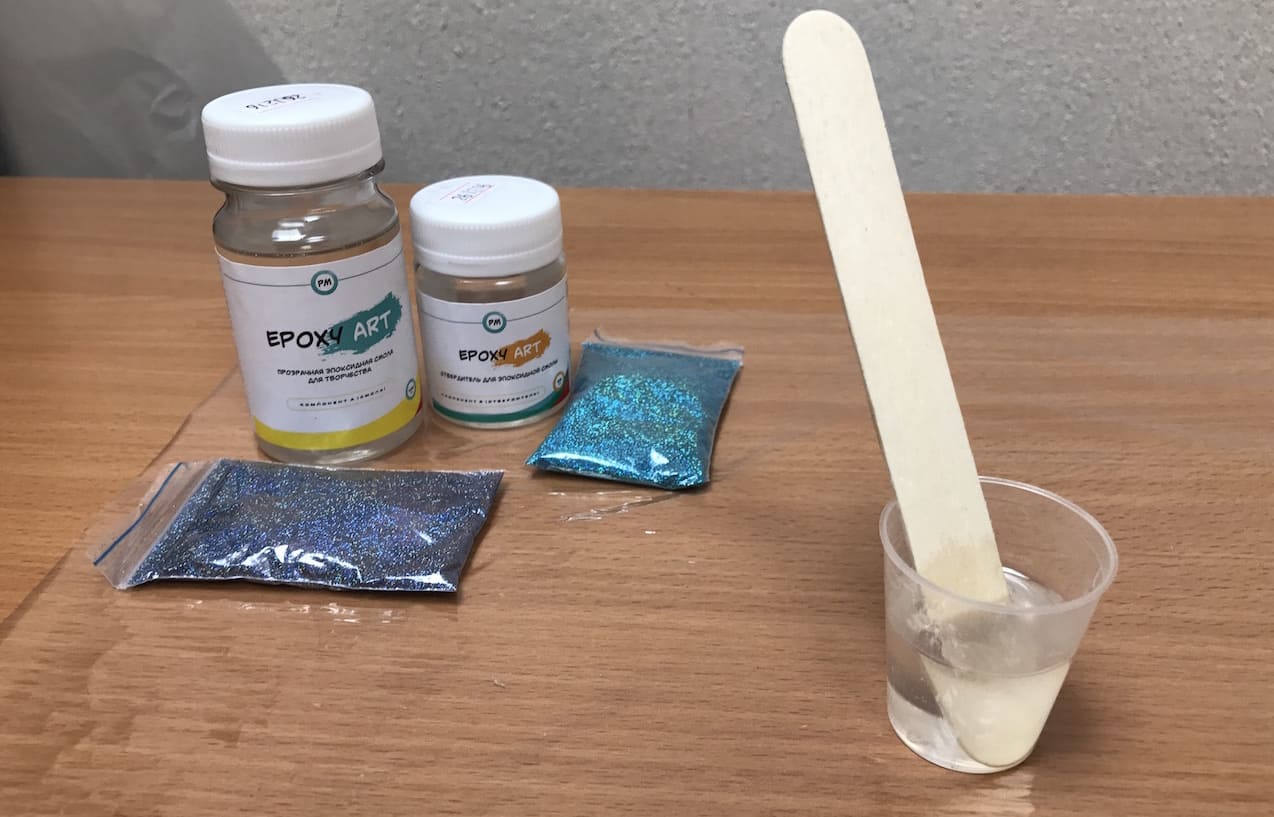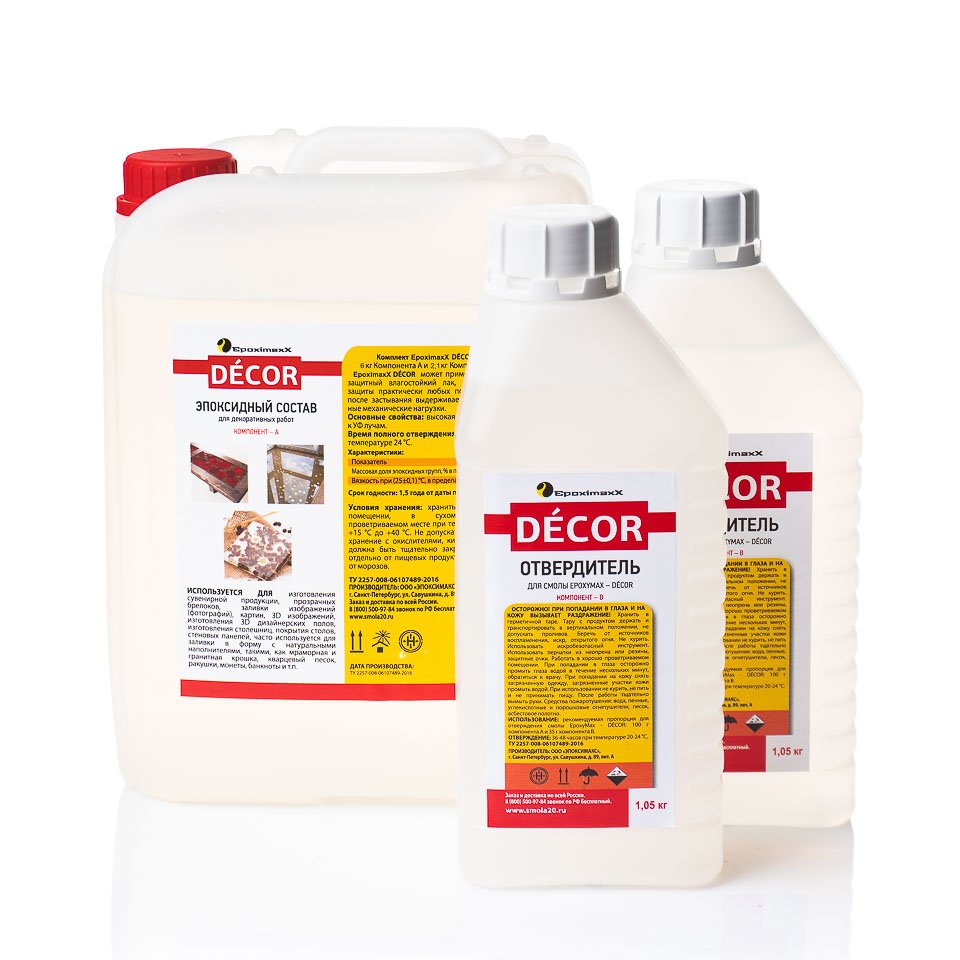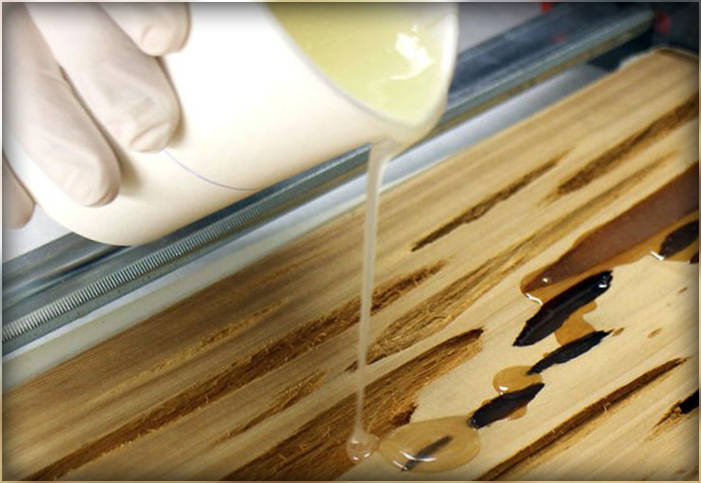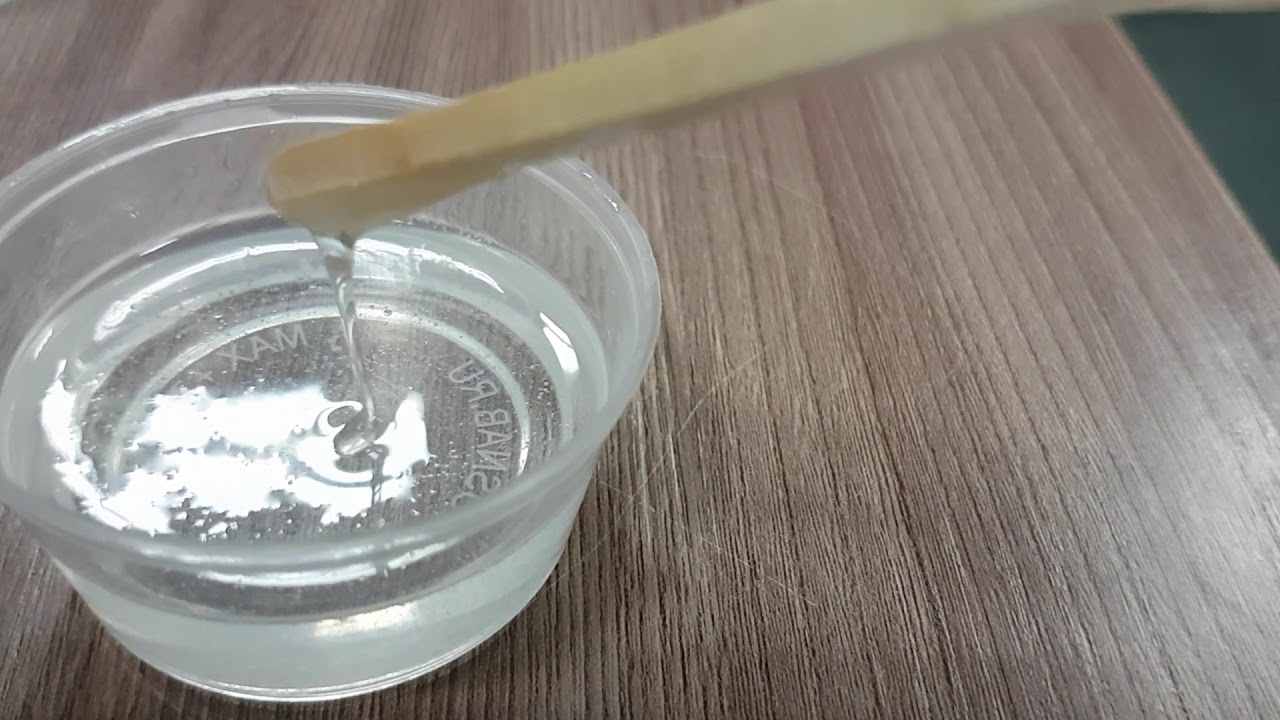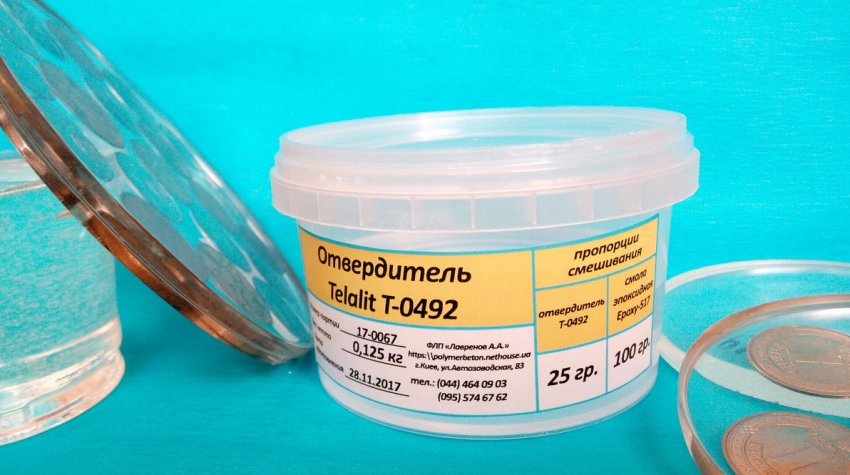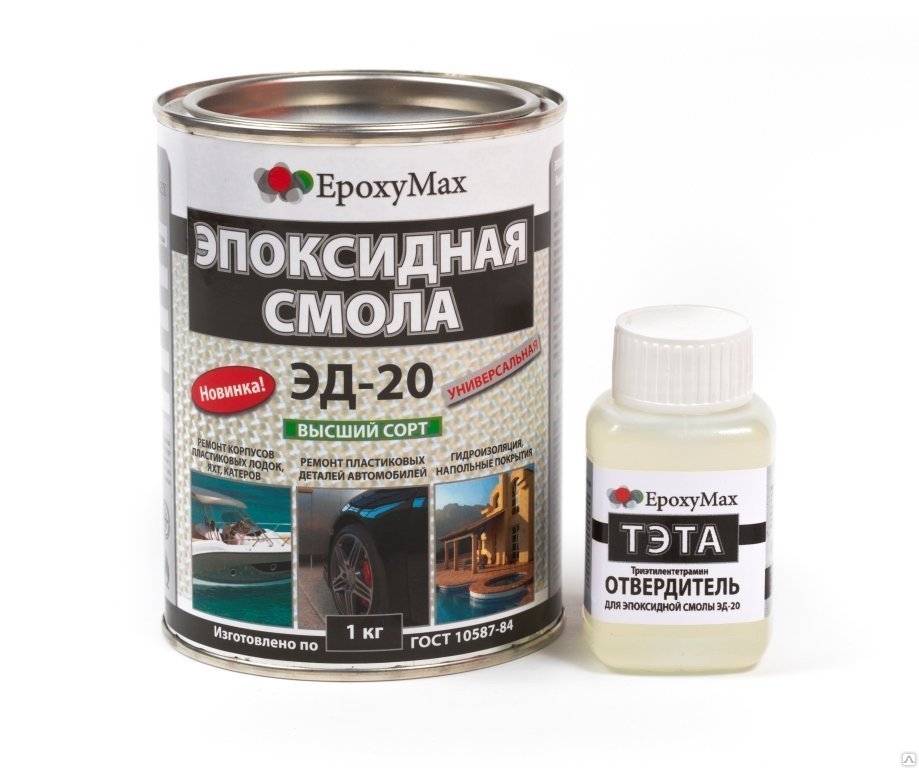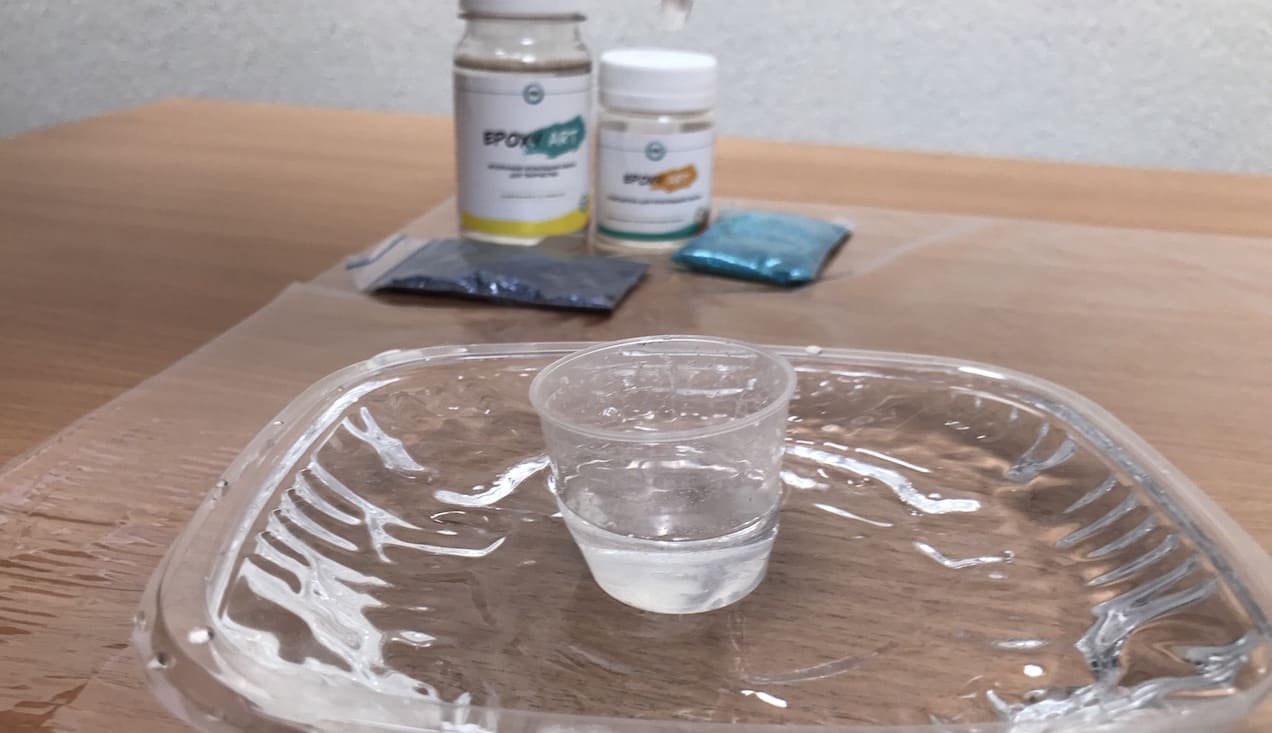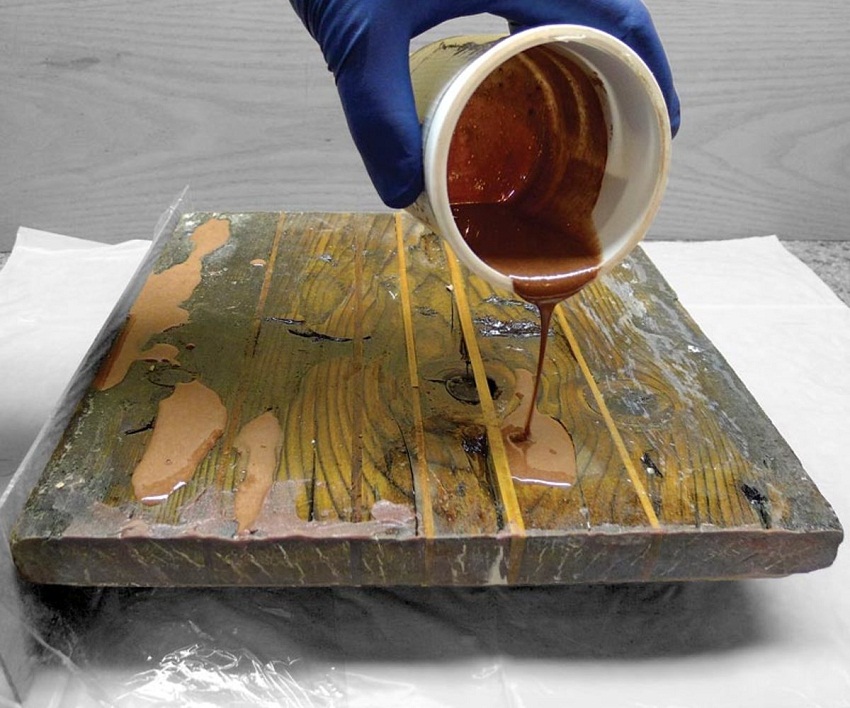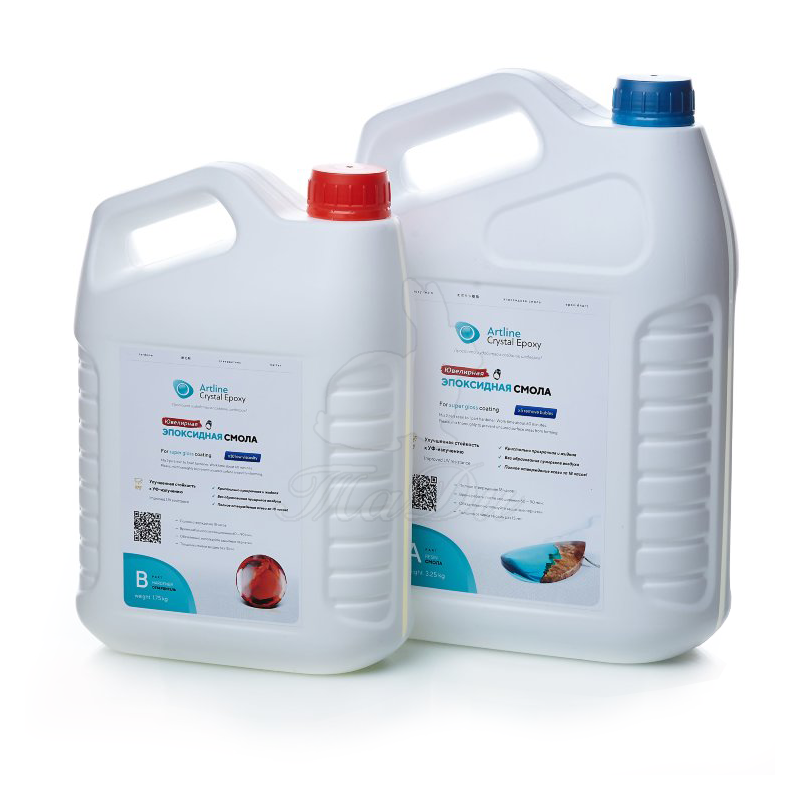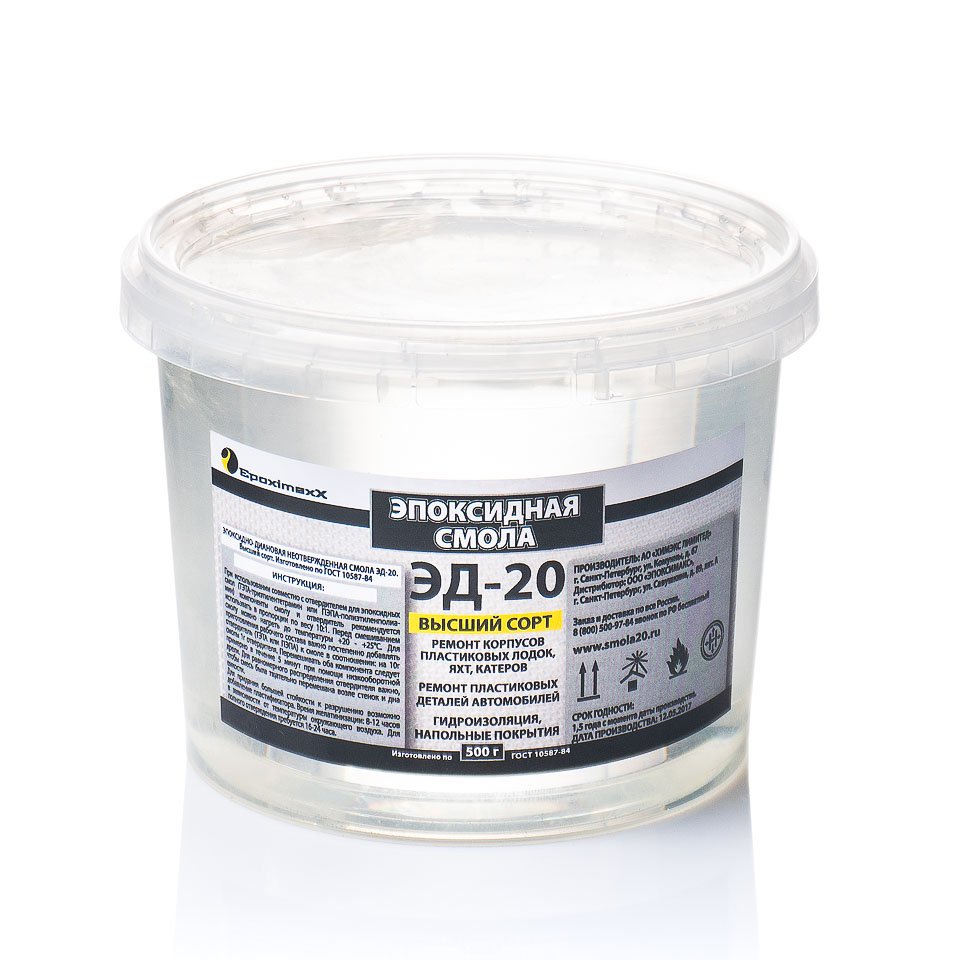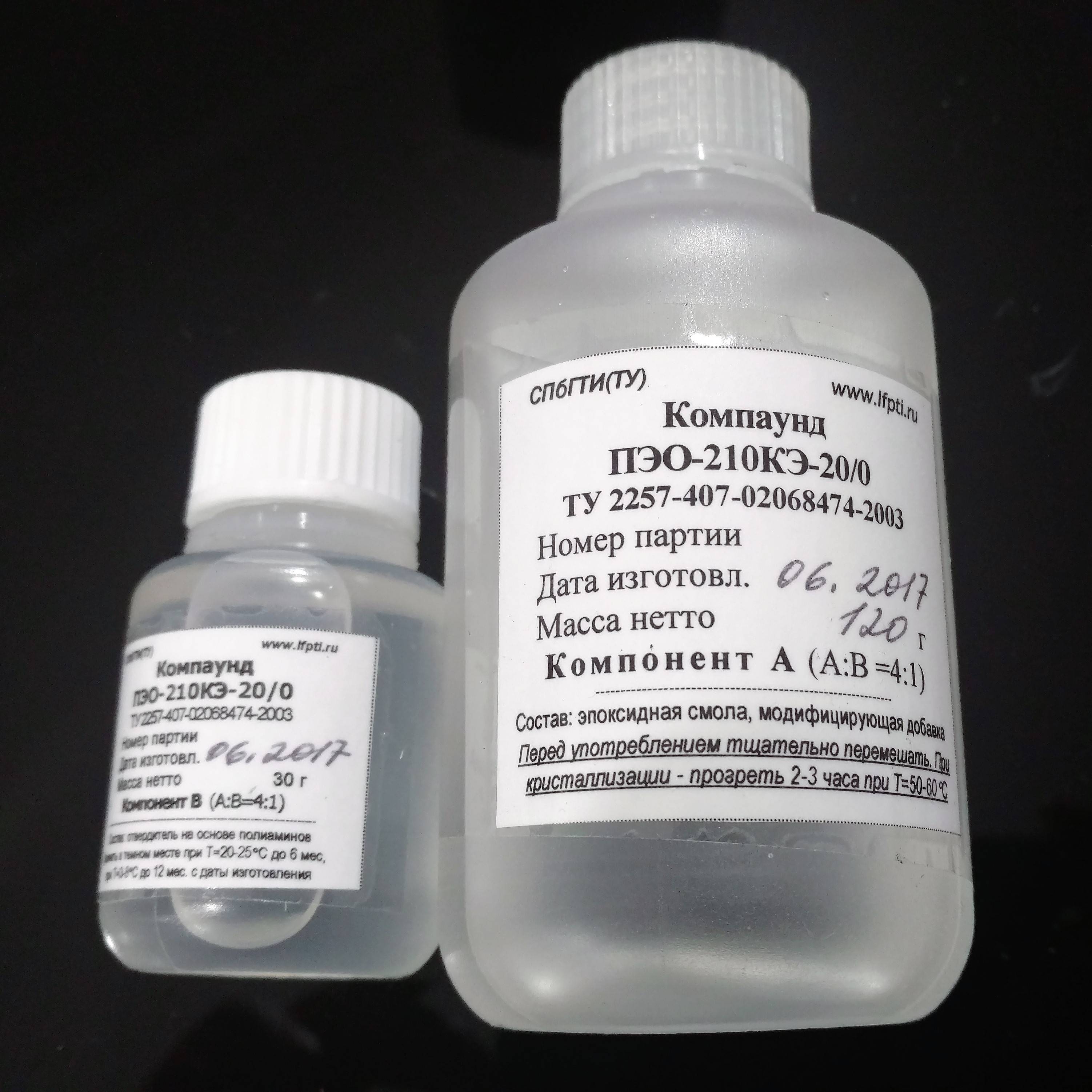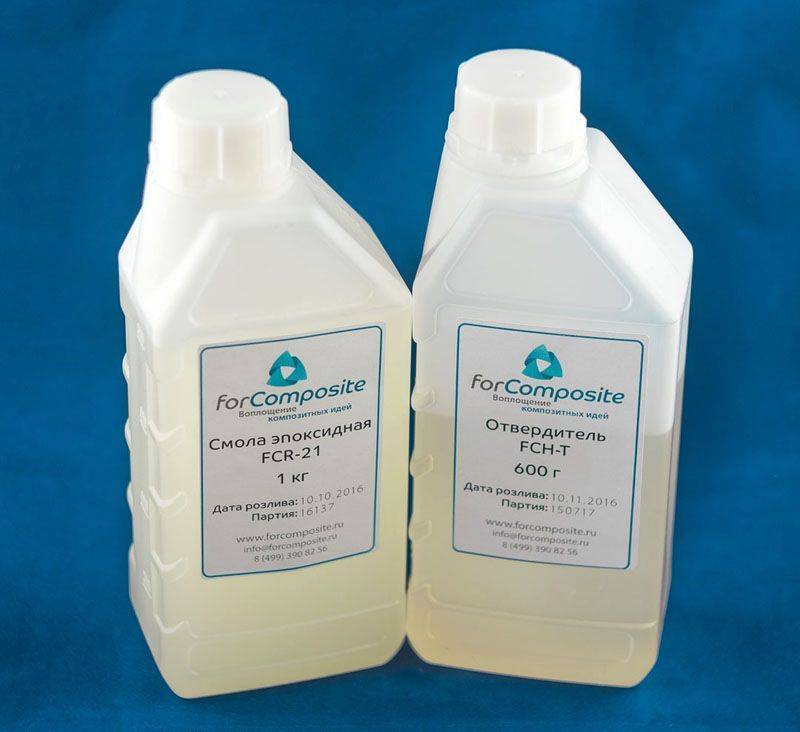Chemical composition and components for epoxy resin
Epoxy resin is a solution of monomers, oligomers or polymers containing at least two epoxy or glycidyl groups. They are located at the ends and along the main chain of the molecule or in the alicyclic ring and are capable of forming crosslinked polymers under the action of a hardener.
Hardeners and plasticizers
In order for the epoxy to become a full-fledged polymer, two components are added to it as a base: a hardener and a plasticizer.
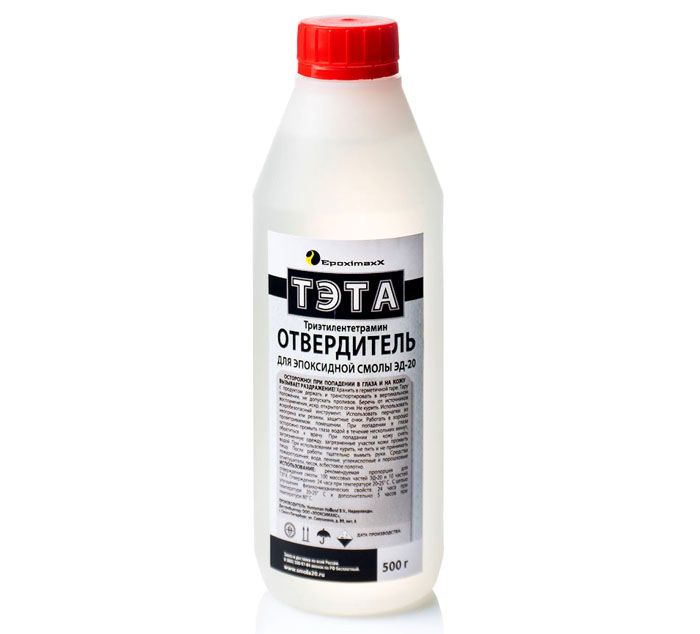
The temperature at which the curing process begins is considered to be -10 ° C, the upper limit for some resins will be + 200 ° C
The proportions of base and hardener are variable, and here it is important to remember that the polymerization process is irreversible. An excess or lack of a curing component affects the quality of the product: the promised strength, resistance to heat, aggressive chemicals and water will not be available, the substance will be sticky
If the product should not be fragile, a plasticizer is added. If you ignore this element, then a large product will be brittle and cracked. There is a universal plasticizer dibutyl phthalate (DBP), but since it does not react very well with epoxy, the whole composition is heated to 60 ° C for 3 hours, stirring constantly. DEG-1 resin is also a plasticizer that reacts well with the base and gives a good plastic effect. The disadvantage of such a component is that it gives a brown tint to the final product.
Fillers and solvents
To save an expensive base, a filler is introduced into its composition. Usually this component is represented by a finely dispersed mineral powder. Both Portland cement and quartz sand can be used. When fillers are included, the fragility of the product increases.
For some oligomers (ED-16 and ED-20), due to their characteristics, the addition of acetone, alcohol, benzene or ethyl acetate is required. This allows you to add more filler to a high-viscosity liquid, but the composition becomes flammable and explosive. Slamor, a shale modifier, is a good solvent.
What can be made from epoxy
Not so long ago, epoxy became a discovery. The substance itself has been used since the middle of the 20th century, but it has gained particular popularity in recent years.
Epoxy Jewelry: A Frozen Tale
Creative people once decided to try to repeat a natural miracle: if the insect is frozen forever in amber, then you can probably try to use epoxy for the experiment. It is not known who first came up with this idea, but it became the impetus for a whole trend in Handmade: jewelry made of epoxy resin Crystal is divinely beautiful.

If you have a question, what is jewelry resin, you can answer this way: these are unlimited possibilities for creating exclusive jewelry

To create unique jewelry, molds are needed for pouring epoxy resin: these can be improvised containers, and purchased figurines, and special molds.
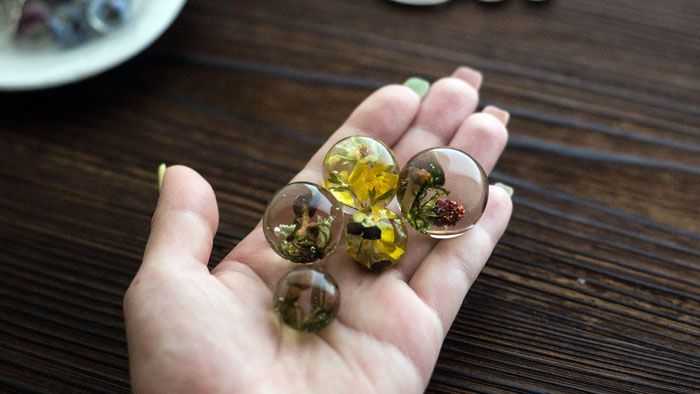
This is a great way to preserve the memory of a season or a special event.

Pendants keep their original look forever
Lovers of special jewelry do not stop at the already tested products and are constantly looking for new solutions.
Furniture made of wood and epoxy resin: a new word in decor
Transparent epoxy resin began to be actively used for pouring wood. It turned out that it is not so difficult to create a table from literally any processed driftwood, and it quickly turns into a magical miracle.

Tables can be kept transparent or get their own color at the request of the creator
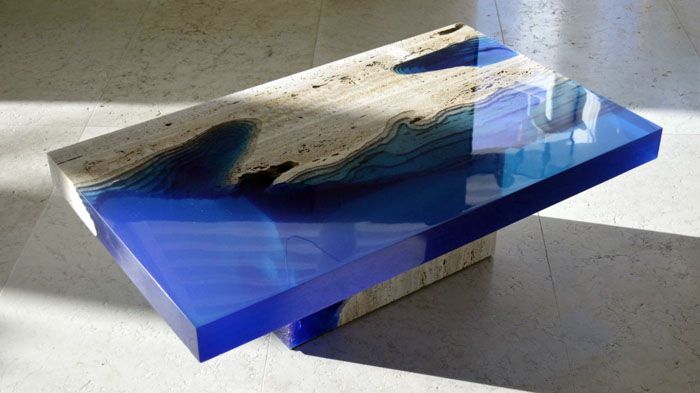
Looking at a tree in resin is a pleasure
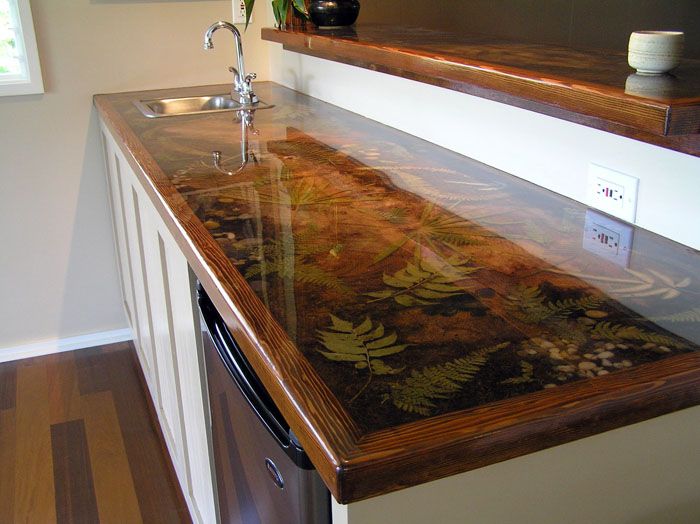
Wood and epoxy worktop can cause envy mixed with admiration
Epoxy wood glue is made by mixing resin with some hardener. This glue is suitable for various non-porous surfaces.
Filling the floor with epoxy resin
Due to its performance characteristics, epoxy has been successfully used for pouring floors: wonderful 3D floors have earned all the praise.

No seams: smooth, perfect surface with high strength
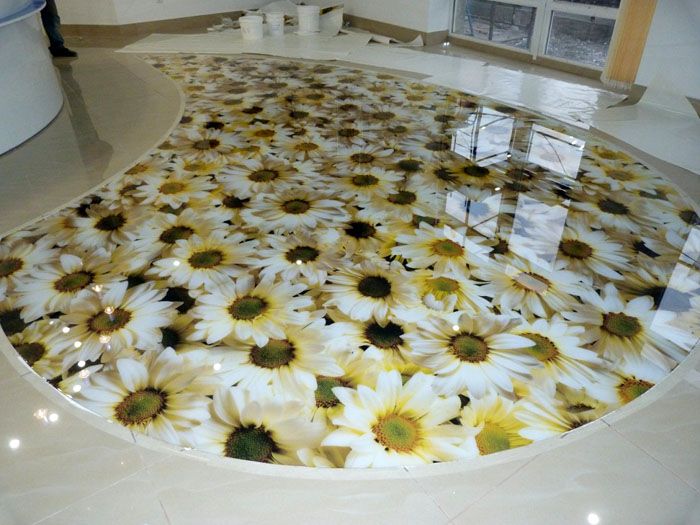
Such a floor is resistant to low and high temperatures, remaining intact
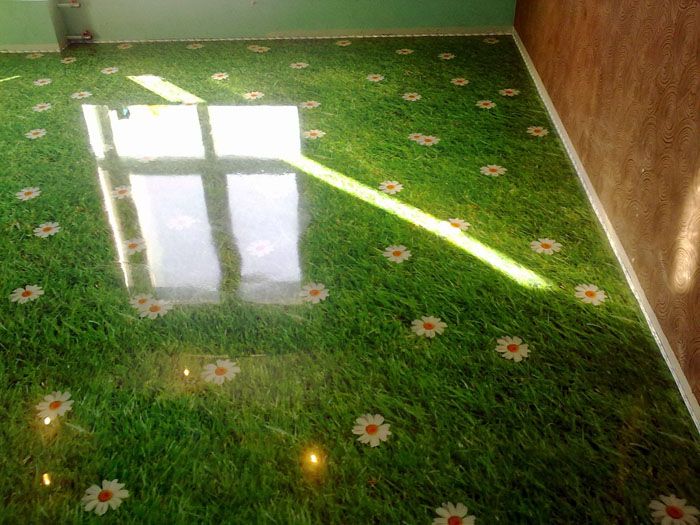
Long-lasting beauty, resistant to aggressive household chemicals
The disadvantage of flooring can be considered high labor costs and financial investments. For a floor to be truly durable, it must be poured in strict accordance with the rules.
Other areas of application
Above was listed the modern use of epoxy in different directions of design and Handmade, but there is also a traditional use that goes back more than half a century. Glass fabrics are impregnated with epoxy, and various elements in the field of electrical engineering, radio electronics, automotive and aviation industries are glued with it. The resin has found its application in construction, ship- and mechanical engineering. In construction, epoxy is an excellent material for waterproofing premises.
Related article:
What can be made from epoxy: interesting examples
If you decide to get creative, we suggest looking at what you can do with epoxy. We have collected vivid examples for you that you can use as an idea for subsequent implementation.
 A beautifully decorated product can be an ideal gift
A beautifully decorated product can be an ideal gift
Epoxy Resin Jewelry
If you want to become the owner of a unique piece of jewelry, you should find out what it is - jewelry resin. It is a modern chemical material actively used by many craftsmen to create handmade jewelry. It allows you to form a product that imitates glass. We offer you to see photos that clearly demonstrate how jewelry epoxy resin can be used.
Wood and epoxy furniture
The combined use of wood and epoxy has a beneficial effect on the performance of the finished product. Under the influence of epoxy glue for wood, the wood is stabilized and ceases to be afraid of an external negative product. Such furniture can be used in various conditions without fear of damage and loss of presentability. We offer you to look at furniture made of wood and epoxy resin.
1 out of 6
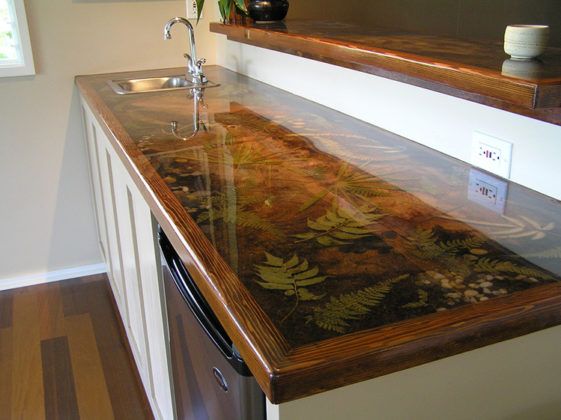

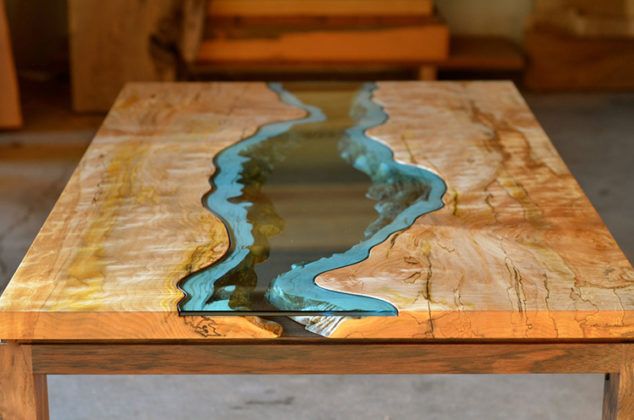
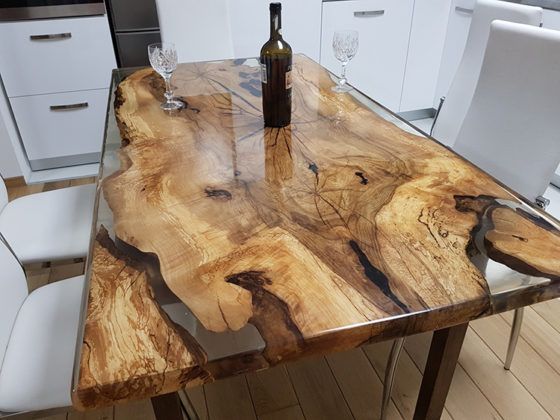

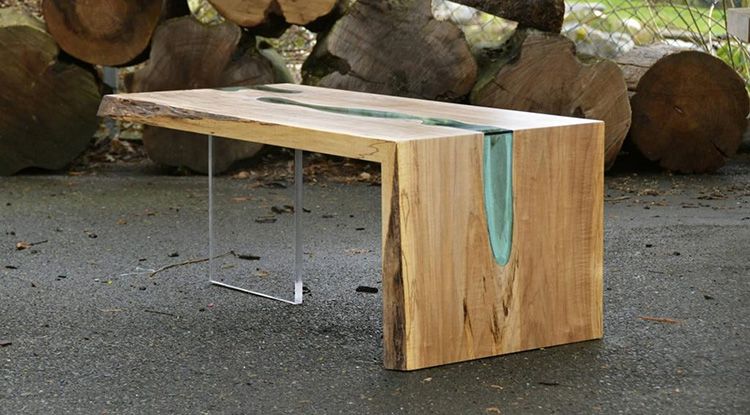
We think you will be interested in a video on this topic.

Restoration of wood and stone products with epoxy resin
Violation of the integrity of the coating is not a reason to throw this or that thing. By applying epoxy to a damaged substrate, you can not only restore its integrity, but also add shine.

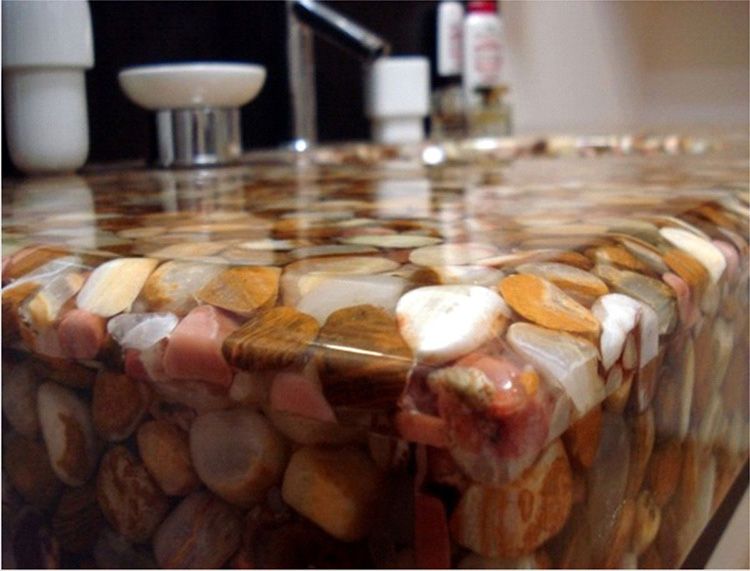
You can restore the integrity of an epoxy and wood product using the correct composition. This opportunity can be used when performing renovation work in the bathroom.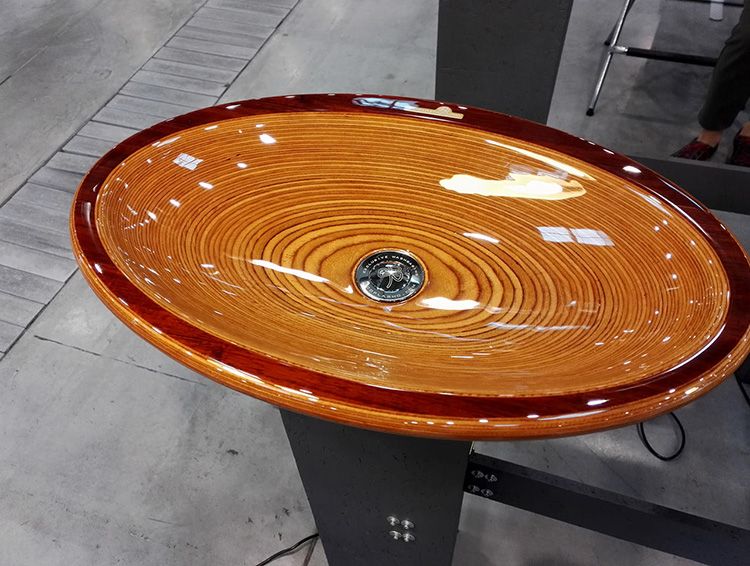
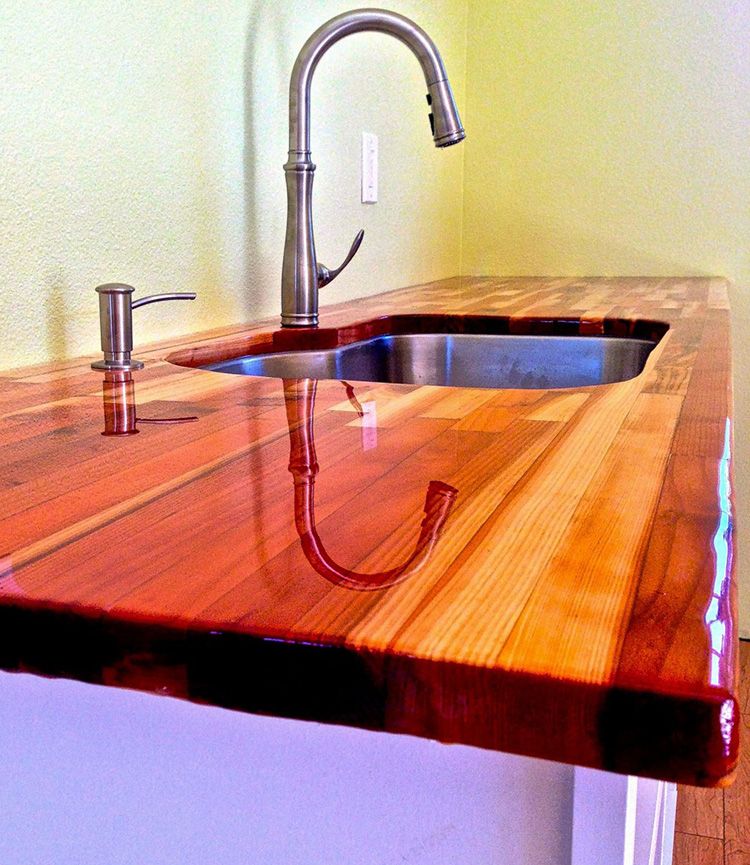
Epoxy resin for flooring
A beautiful floor can become the main decoration of any room. You will not want to lay a carpet on it or provide for any additional protection methods. The formed coating will resist well to external factors. We suggest looking at the photo to see how epoxy resin can be used to fill the floor: it can be used to form a self-leveling floor with a unique pattern.
1 out of 6
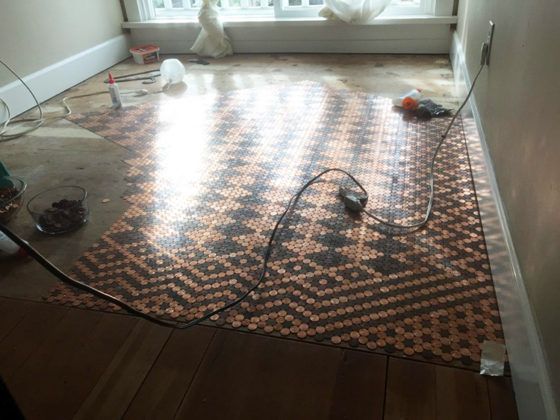

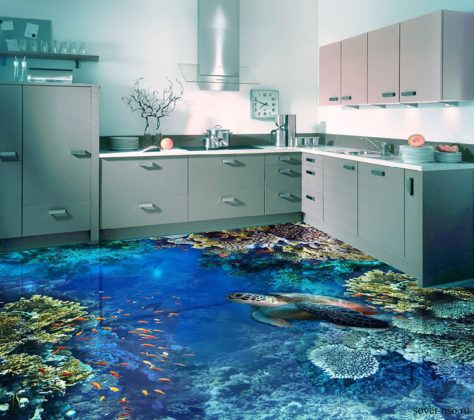

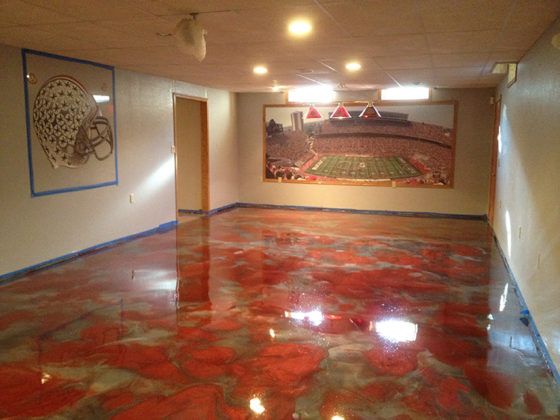
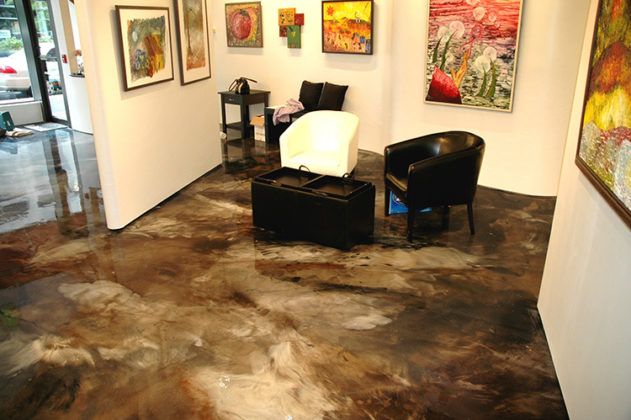
Other areas of application
Epoxy has a fairly large area of use. It is used:
- when performing waterproofing and repair work;
- for sealing electrical devices. To achieve the best effect, you should figure out how to glue with epoxy;
- to strengthen the plaster;
- to protect products used in aggressive environments.
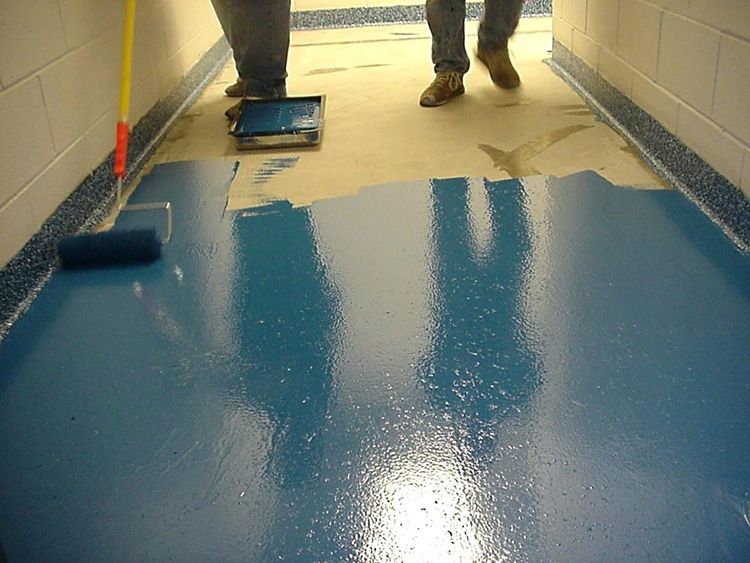 The composition is effective for waterproofing the floor
The composition is effective for waterproofing the floor
Chemical composition and components for epoxy resin
To obtain the necessary properties during the preparation of the solution, special components are added. We suggest you find out what exactly can be added and in what quantity.
Hardeners and plasticizers
The resin is mixed with a hardener to initiate the polymerization reaction. Phenols, tertiary amines and their analogs can be used as this agent. The amount of hardener added depends on the characteristics of the base component and the desired result.
 One of the hardeners that allows you to start the polymerization reaction
One of the hardeners that allows you to start the polymerization reaction
So that the finished product does not crack during operation, has sufficient flexibility, a plasticizer is introduced into the composition of the prepared mixture. The introduction of this component will prevent the formation of cracks during the drying process of a large-volume product. A dibutyl phthalate-based substance is used as a plasticizer.
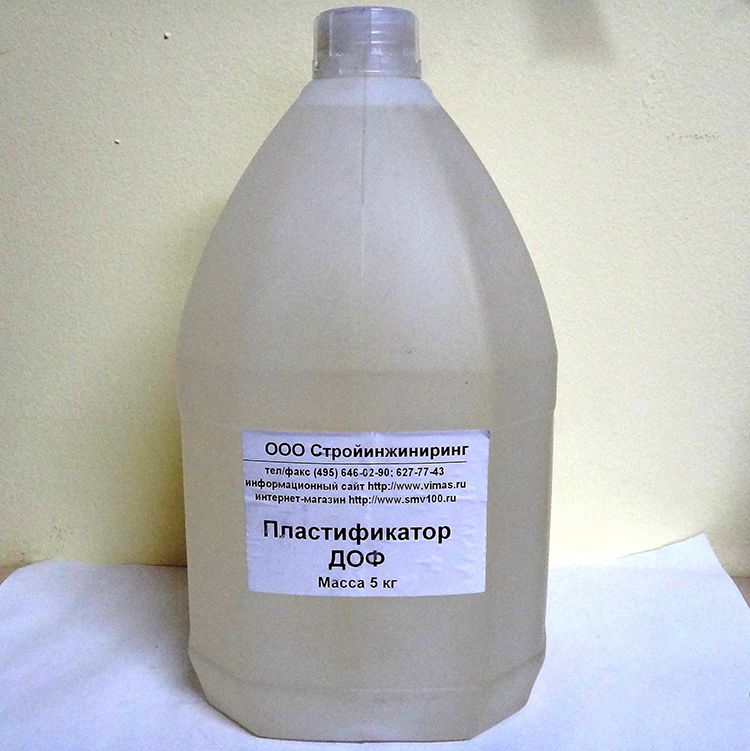 The plasticizer maintains the integrity of the formed surface
The plasticizer maintains the integrity of the formed surface
Fillers and solvents
To impart the required complex of properties and the desired shade or color, various fillers are introduced into the composition of the epoxy resin. Most often, preference is given to:
- aerosil, allowing to prevent the appearance of smudges on vertical surfaces;
- a microsphere that increases the viscosity of the composition;
- talcum powder, which ensures the formation of an even and sufficiently durable surface;
- titanium dioxide, which increases the resistance of the material under the influence of ultraviolet radiation and gives the coating a white color;
- aluminum powder, which gives a characteristic silver-gray color;
- graphite powder to achieve the desired color and ensure the formation of a perfectly even structure.
Solvents are sometimes added to reduce the viscosity of the formulation. However, their number should be minimal, since they lead to a decrease in the strength of the formed coating.
 The amount of added filler affects the color of the future product.
The amount of added filler affects the color of the future product.
Scope of the tool
Compositions based on transparent epoxy are used for the manufacture of jewelry, key rings, pendants, bijouterie, various figurines and decorative items. What else can be produced with this resin? The list of applications also includes advertising products, souvenirs, countertops, bathroom products, plumbing parts.
One of the main uses for epoxy is self-leveling floors with unique patterns. Also, the tool is suitable for creating glazed surfaces, mosaics, volumetric decoupage. In general, the use of a transparent compound can be broader and is limited only by the user's imagination. The material is perfectly combined with wood, stone, beads, sand, dried flowers, insects, coffee beans.
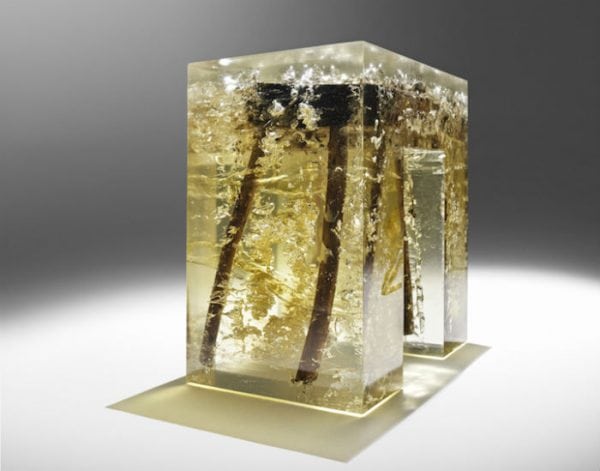
Luminophores (components that glow in the dark), glitter can be added to the polymer resin. Backlighting is often installed inside the countertops, and the LEDs create a soft, pleasant glow. For epoxy, special dyes are sold with a small particle size (5-200 microns). They are evenly distributed within the layer, creating a uniform shade without unpainted areas.
Other uses for epoxy:
- waterproofing for various industries, sealing and sealing of electrical devices;
- covering the walls and bottom of boats, car parts;
- impregnation of fiberglass, glass mats, fiberglass and yarns;
- reinforcement of plaster, strengthening of thermal insulation of premises;
- priming of walls, floors, porous surfaces;
- protection of products that are exposed to aggressive chemicals and water.
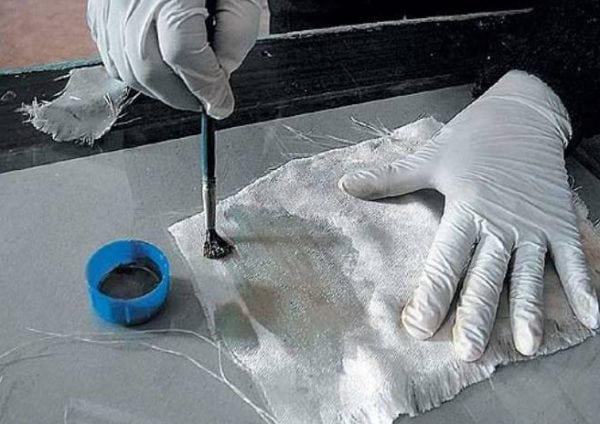
DIY epoxy resin products - nuances
To make an epoxy product perfect, you need to remember some points of manufacture:
- the surface to be treated must first be degreased;
- the gloss on the surface is removed by grinding with sandpaper or a special machine, the dust is removed with a vacuum cleaner;
- if the work is performed by overlaying layers, then they are applied to the incompletely polymerized previous layer;
- at the beginning of work, the resin is liquidish and perfectly fills all corners of the form, and after slightly thickening, it forms lenses well;
- epoxy resin will not glue polyethylene, silicone, polypropylene, rubber, but these materials are very suitable as forms;
- in the process of hardening, the rubber phase sets in - at this time the product can be bent, if necessary, but it will be necessary to fix it in this position.
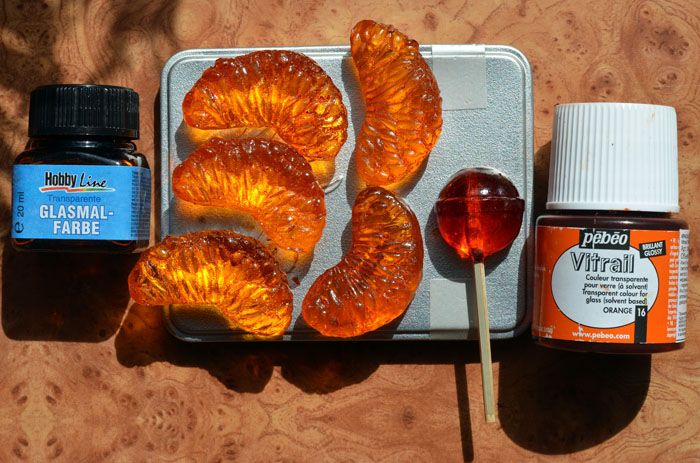
The resin is perfectly colored with toner, helium pen ink, felt-tip pen paints, stained glass paints
It is unacceptable to work with high air humidity and do not allow moisture to get into the resin. It also makes no sense to make products at high temperatures, the composition can boil and form a lot of bubbles.
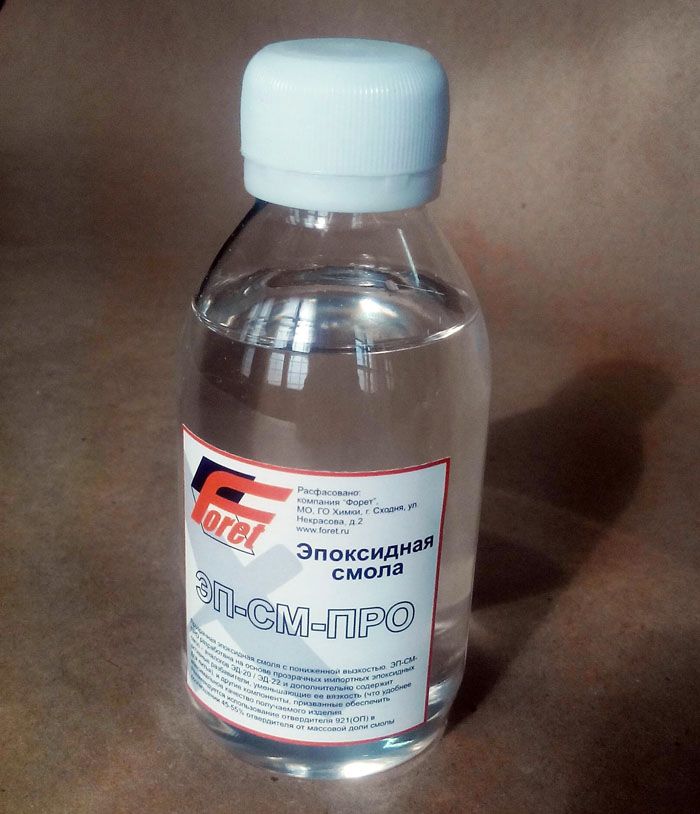
Due to the fluidity of the substance, it makes no sense to try to replace the varnish for embossed objects, and if it is a flat object, then it should be located strictly horizontally
When a bubble appears near the surface, it must be blown through the beverage tube.
Transparent Fill Resin Basics
Many craftsmen successfully work with epoxy at home, using adhesives based on it, repairing various objects and products. But the instructions for using transparent material are much more complicated. It is difficult to create a perfectly smooth, even surface with your own hands the first time, you have to practice. Careful study of the information will help ensure an excellent quality of filling without bubbles and other defects (oil stains, chips, bumps).
Self-leveling floor masters use the technique of rolling each layer until the polymerization begins. The worker walks on spikes that prevent the floor from being damaged; rolling is also not easy - he needs a toothed roller for polymer coatings. It looks like a massage comb. After applying the roller, all air bubbles are removed from the mass mass. It is easy to guess that it is problematic to carry out such work yourself.
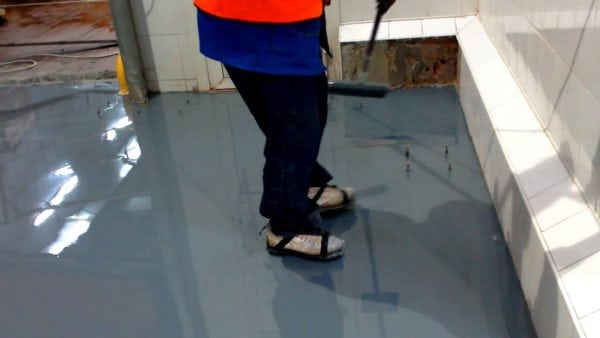
Much less effort is required to make jewelry, fill small items (badges, labels, souvenirs, natural materials). You need to prepare the following tools and materials:
- form with or without a separator;
- epoxy resin and hardener;
- dyes;
- wooden stick;
- disposable tableware.
Usually, 100 g of epoxy requires 40 ml of hardener, but the proportion may be different, depending on the manufacturer's recommendations. The resin mass needs to be slightly warmed up without removing it from the package. To do this, it is placed in warm water (water temperature - 60 degrees) for 10 minutes. Then they put the product in a dry disposable dish or other container, which can then be thrown away. The mass is thoroughly mixed within 3 minutes.

For direct work and obtaining an ideal result, it is imperative to comply with the following conditions:
- room temperature - 25-30 degrees;
- low air humidity - up to 55%;
- absence or minimum content of dust, pollutants in the air, in the working area.
Other conditions will negatively affect the final result. Moisture is especially harmful for transparent epoxy - the resin deteriorates not only from direct contact with water, but also from high humidity. All work surfaces are set horizontally in level, otherwise the finished product will be uneven.It must be remembered that the form will remain in one place until complete polymerization, and it must be placed where it is convenient. After pouring the next layer, it is necessary, if possible, to cover the product from dust.
The order of work is as follows:
add the hardener to the mixed resin in the proper ratio;
stir the product for 15 minutes, but without intensive movements;
if there are air bubbles, they must be removed by immersing the mass in vacuum or by heating the resin with a burner flame (it is important not to overheat the mass above 60 degrees, otherwise it will deteriorate);
Remove bubbles adhering to the surface of the resin with a toothpick - pierce them, it is also permissible to pour a little alcohol on the mass;
leave the completed layer to dry.

During the first 30-60 minutes, you will see how high-quality the fill turned out to be. If the mixture exfoliates, the density of the components is not the same, the proportions are chosen incorrectly. It will also cause surface streaks and blemishes. Full polymerization takes 24-48 hours depending on the grade of epoxy and layer thickness. It is not recommended to do it more than 1-2 cm, especially for beginners. Any contact with an uncured mass leads to marriage.
Acceleration of resin hardening is permissible. For this purpose, after the initial curing (after 1-2 hours at +25 and above), you can transfer the mold to the dryer at a temperature of +70 degrees. The product will be ready in 6-8 hours. For the first time, it is not recommended to use portions of resin more than 200 g. It is with this amount that you can clarify the procedure for working, the hardening time, besides, the indicated weight is completely poured into one layer.
The time between pouring individual layers should not be less than 18 hours. Further, the surface of the previous layer is sanded with sandpaper with a very fine grain, after which the subsequent application of the compound can be performed. The time before active use of a multilayer product is at least 5 days.
Technological features
When analyzing the question of how to fill a tree with epoxy resin, you need to take into account some of the features of such a material. The structure of the tree is not uniform, and air bubbles can accumulate inside it. And when the temperature regime changes, the wood begins to change (expand or contract). The accumulated air begins to come to the surface, spoiling the finished work.
To prevent this, when pouring resin into a tree, it is necessary to take into account the temperature of the working room: namely, 2-3 hours after the end of the work, provide a temperature regime of + 20-25⁰С. If it is planned to pour a thick epoxy layer, then the whole process must be done in two stages - this way the risk of the appearance and release of air is minimized.
How to properly impregnate wood
Before using epoxy resins for pouring wood, the working material (wood) must be heated. This process leads to the expansion of wood pores, and better penetration of the resin. After the surface has hardened, the fill is subjected to the required finishing treatment.
How to eliminate the appearance of air bubbles
If all measures have been taken, but air bubbles have appeared on the surface of the resinous substance, they can be removed. It is not worth heating the surface - this will lead to the appearance of new air pockets. You should use one of the following options:
- Using a fine needle, carefully pierce the bubble.
- Spray the surface with an alcohol solution using a spray bottle.
- Air pockets that are too large are drilled. The resulting cavities are cleaned, the surface is degreased and a second layer of filling is applied.
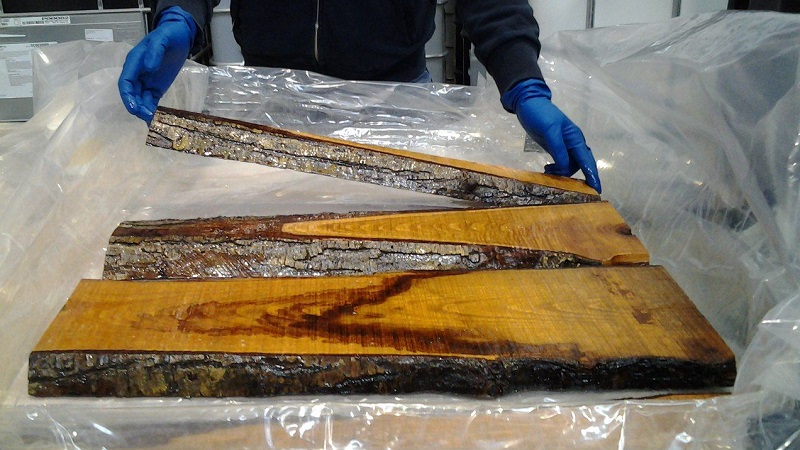 Working with wood and resin requires adherence to all stages of production
Working with wood and resin requires adherence to all stages of production
What can replace epoxy hardener
The main task of this composition is to change the molecular structure of the resin, turning it into a polymer compound, that is, to carry out polymerization. Several substances act as a necessary substance.These are diamines, amines, acids and acidic anhydrites.
All epoxy solvent substances are divided into two major subgroups:
- The base is acid. Acid PEPA enter into the required reaction under the influence of high temperatures (the resin is heated to + 200⁰C).
- Amines and their compositions. Such hardeners are used in everyday life; high temperatures are not required to change the properties of the epoxy. Heating can only speed up the polymerization process.
Therefore, speaking about whether it is possible to make a hardener for epoxy resin with your own hands at home, the method of using amines is being considered. Substances of this type include the following substances:
- polyethylene polyamine (PEPA);
- triethylenetetramine (TETA);
- aminoacrylate.
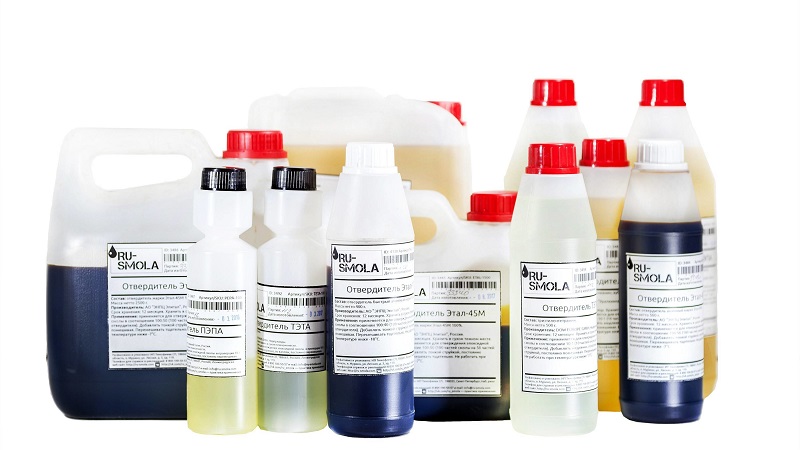 A special composition acts as a hardener
A special composition acts as a hardener
We make the hardener ourselves
Making a hardener for epoxy resin with your own hands is available, but on condition that the master can get all the necessary components. The necessary items can be purchased in specialized stores. In the public domain, you can find such components of the composition as:
- Etal-45M;
- CHS-Hardener P-11;
- Telalit 410;
- Diethylenetriamine.
The quality of the hardener will have to be assessed only empirically, through our own tests - mixing the resin in the specified proportions. By the way, a medical syringe will help in conducting tests and determining the required amount of hardener - it is convenient for them to collect a replacement substance and dispense it when combined with epoxy.
Suitable analogs
Sometimes, when using epoxy in art, the hardener attached to it is consumed too quickly. What can replace it? You can try the following connections:
- ammonia;
- benzoyl peroxide;
- orthophosphoric acid.
 One of the components of a homemade hardener is ammonia
One of the components of a homemade hardener is ammonia
But you need to understand that although there is some alternative to epoxy hardener, the substitute does not always give the expected, good result. Therefore, for some large-scale creative work, nevertheless, buy the original substance in sufficient quantities.
Rules for diluting resin with a hardener
When these two components are combined, an irreversible reaction occurs. You need to be aware of this and combine the hardener with the resin in accordance with the attached instructions.
If stirring requires heating the composition, also be extremely careful. If you allow the epoxy to overheat and boil, the mass will be spoiled and you can no longer use it. A sign of boiling is the appearance of foam (it is formed when the mass is heated up to + 60⁰С).
When the resin has crystallized, it is brought to the required transparent appearance by heating to + 40 ° C. The mass is regularly stirred when heated. When diluting the resin in a cold way, the mass will generate heat during the polymerization process. In the cold process, the solutions are mixed in a proportion of 10 parts of hardener to 1 part of resin.
Chemical composition and components for epoxy resin
As mentioned above, epoxy resin is a synthetic material based on oligomeric compounds. For its competent use, especially when performing creative ideas, it is necessary to have information about hardeners and plasticizers, fillers and solvents, using which you can expand the possibilities of using this material, as well as secure the performance of work with its use.
Hardeners
The hardener serves to polymerize the composition, under its influence the resin acquires a stable structure. Carboxylic acids and their anhydrides, as well as diamines can act as a hardener. Hardeners are classified as:
- acidic - when used, polymerization occurs at a significant temperature of + 100-200 ° C;
- amine - hardening is carried out at room temperature.
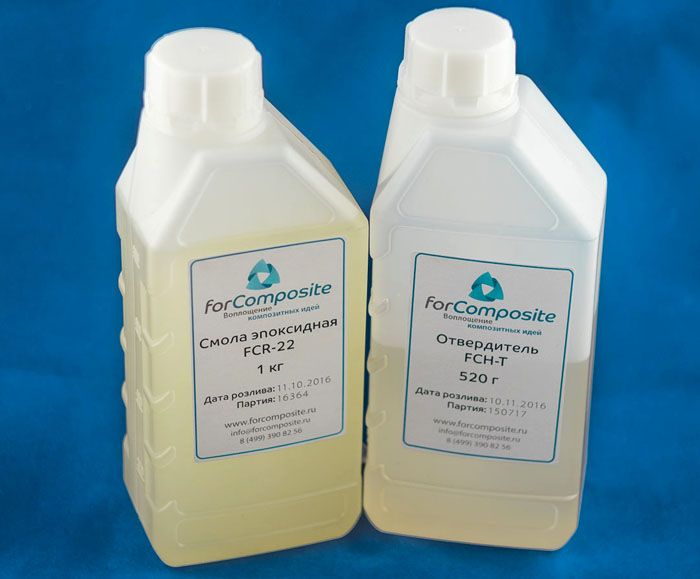
FCR-22 with FCH-T hardener has low shrinkage when used
epoxy resin FCR-22
Amine - this is the most popular type of hardeners, characterized by ease of use and the absence of the need for special equipment for the preparation of the composition. The hardeners of the brands PEPA and DETA, CHS-Hardener P-11 and RC-19, and Epilox H 10-40 are considered the most popular.
Plasticizers
The addition of a plasticizer gives the created composition plasticity and the ability to withstand external mechanical loads in the form of impact or impact on fracture. The most common plasticizers are:
- DBP (dibutyl phthalate) - added to epoxy resin in small quantities, it protects the composition from cracking. The disadvantages of this plasticizer are: poorly miscible with the resin, and when using it requires prolonged mixing and heating;
- DEG-1 - easily mixed with resin, but has an orange color, which limits its use, if necessary, create a transparent structure.
Plasticizers for epoxy resins:
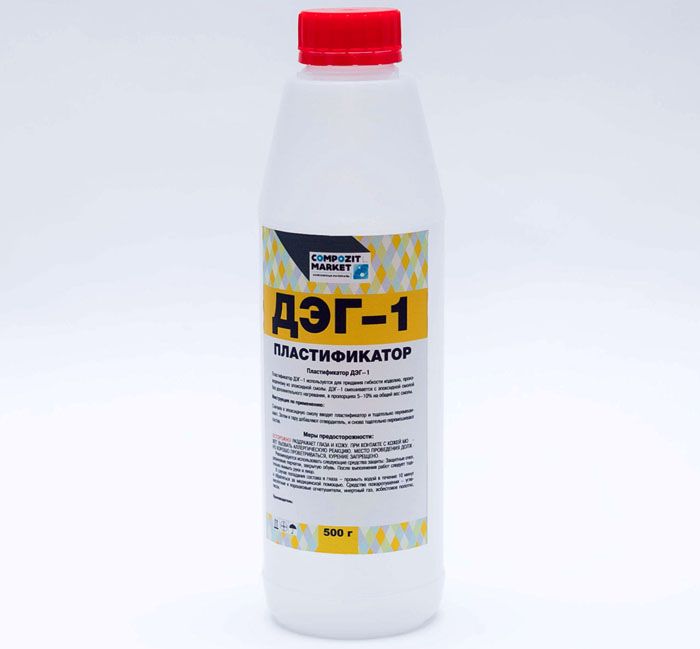
plasticizer DEG-1

DBP plasticizer (dibutyl phthalate)
Excipients
Fillers can be used for technical and decorative purposes. Technical ones provide the necessary viscosity to the created composition, which is required when filling and filling voids in building structures. The most demanded in this group of materials are "Aerosil" and "Microsphere".
Decorative - give the created product a certain color and texture. It can be quartz sand or crumbs of various colors. Colored fillers are especially in demand for a creative approach to the manufacture of products, regardless of whether they are pieces of furniture or decor, flooded floors or jewelry.

Decorative fillers used in the manufacture of various products
Solvents
There are times when the resin gets on the finished product or clothing during the manufacture of something, and it must be removed, while it has time to dry out. In this case, solvents come to the rescue, for which you can use acetone, toluene, ethyl acetate, butyl acetate or liquid for nail polish remover... In addition, solvents are used to reduce the viscosity of the resin, which is necessary when performing some operations with its use.
When using solvents, remember that:
- even a small amount of solvent can significantly reduce the viscosity of the prepared composition;
- the use of a solvent reduces the strength of the final product and the period of its hardening;
- the solvent causes shrinkage and can lead to discoloration of the final product.

